
Collection of Radiation Instrument Advertisements from 1940-1960
As the development of portable radiation instruments emerged, competition began to develop among the manufactures and the race was on for advertising and marketing. The advertisements presented in this section are a sampling of the variety of approaches beginning in the late 1940's through 1960.
The following is an another example of a Detectron advertisement. It states “In 1849, all you needed was a pan and some luck in avoiding Indians, but in 1955 you’ve got to choose the best instrument for your purse and purpose”. Also shown are the Model DG-2 which was the first detector sold by Detectron in the late 1940's and sold for $37.50. On the high price end at $515.00 is the Model DS-235, which was a gun type instrument with a high sensitivity scintillation detector as opposed to the standard Geiger counter.

Detectron Ad 1950
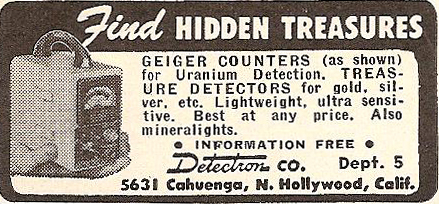
Detectron Ad 1953
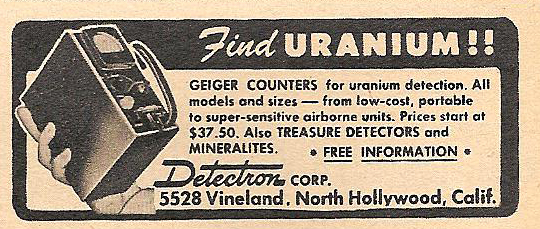
Detectron Ad 1955

Detectron Ad 1955
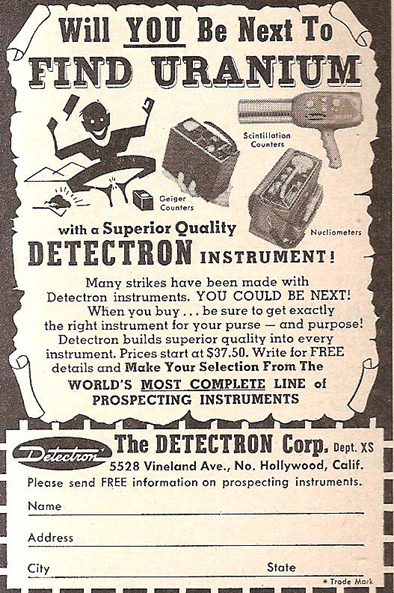
Detectron Ad 1955

Detectron Model DG-2 Ad 1955

Detectron DS-235 Ad 1955
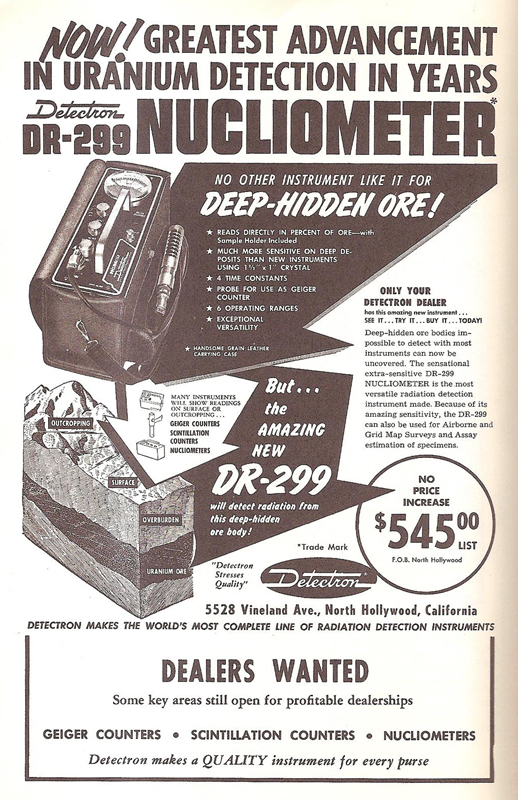
Detectron Ad 1955
The Detectron 390-B was described as the “New Bismuth Nucliometer” and was designed to aid in locating mineral deposits. It contained 24 bismuth geiger tubes. The insides of the tubes have a bismuth-coated screen that ionizes the gas more efficiently, thus increasing the sensitivity over normal geiger counters by a factor of 2.5 to 5. This sensitivity increase is useful for weak or distant anomalies. The unit would have sensitivity with 24 tubes from 50-100 times higher than a single geiger tube. Sensitivity was 0.005 mR/h to 0.5 mR/h. It originally sold for $1295 in 1955.

Detectron Bismuth Nucliometer Model 390-B 1954
Omaha Scientific offered a line of radiation detectors in the 1950's. An example of the advertisement for the Model TX-8 is shown below. During that period, most of the commercial low cost detectors were advertised for uranium prospecting which became a popular recreational past time for prospectors and hobbiest. It advertised as the "World's Largest Exclusive Manufacturers of Geiger Counters for Prospectors".
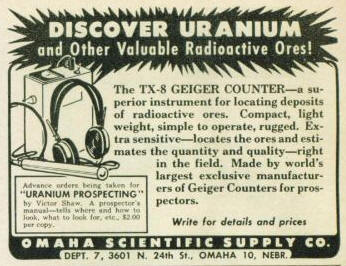
Omaha Scientific Model TX-8 Ad 1950's
Precision Radiation Instruments (PRI) produced a line of radiation detectors beginning in the late 1940's. The push was on for compact, lightweight geiger counters useful for the early stages of the uranium rush. The Model 101 shown below was their first product and is illustrated in the 1948 ad as being very light weight, being held by a single finger.

PRI Model 101 Ad 1948
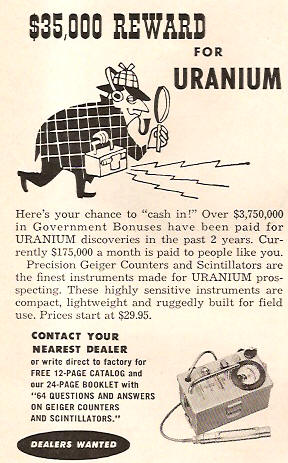
PRI Popular Science Ad 1955
Also during the late 1940's, the U.S. government began offering uranium prospectors rewards of up to $10,000 for locating radioactive ore deposits. At the time, the government needed to find uranium ore deposits to meet the growing demand for uranium for developing atomic weapons program. The ad below is for PRI's early model which weighed only 2 lbs. and sold for $49.50.
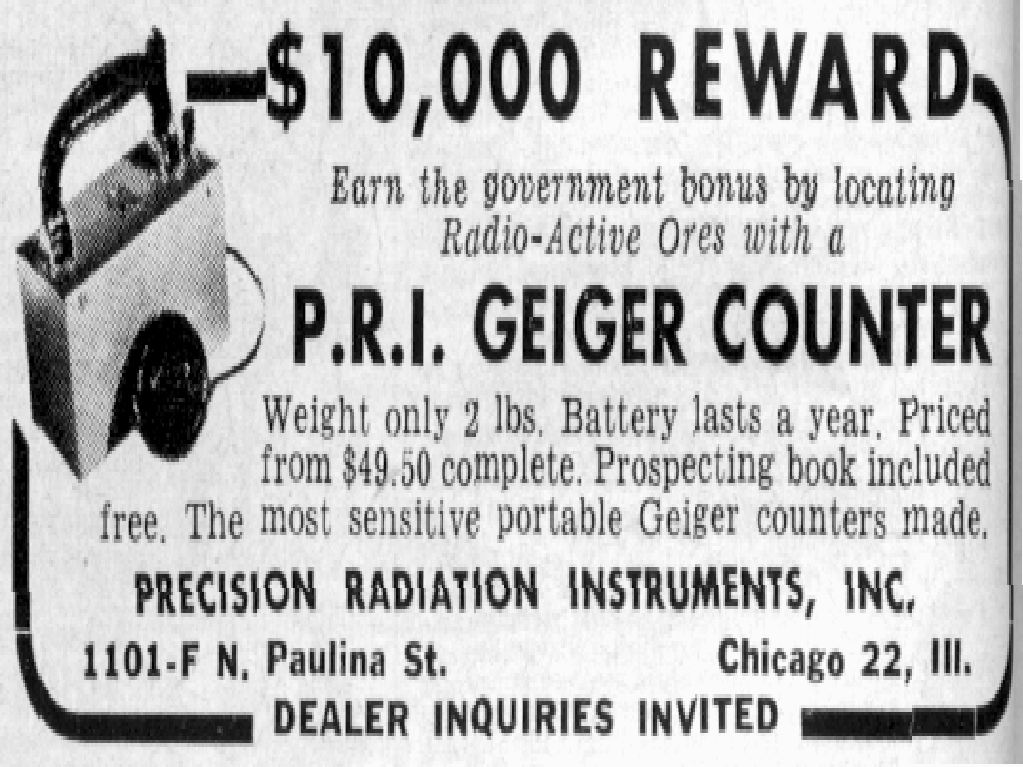
Popular Science Ad 1949
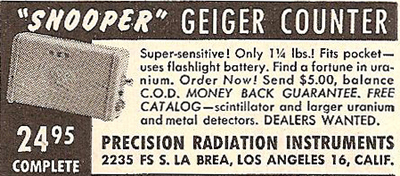
PRI Model Snooper Geiger Counter Ad 1953
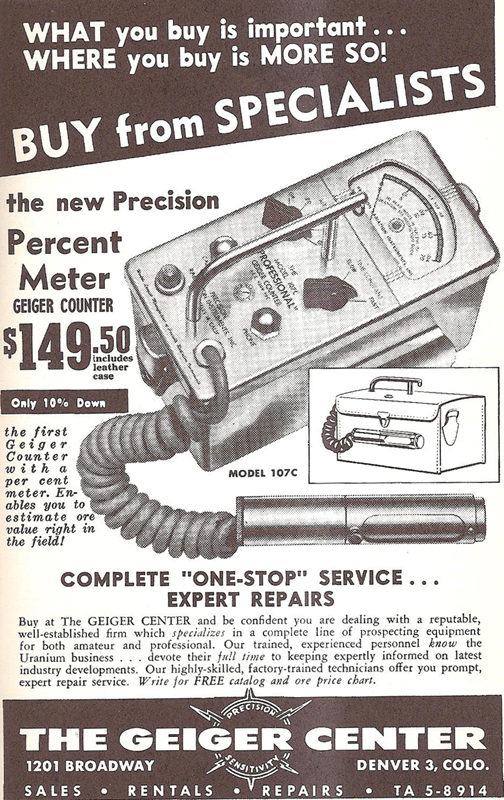
PRI Model 107C Ad 1955
In the mid-1940's, the detection business took a significant leap in sensitivity with the introduction of the sodium iodide scintillation detector. Being a solid material as opposed to a gas in the geiger counters, its sensitivity to stopping gammas increase significantly. As such, a prospector could detect the uranium at much greater distances, even riding in a car or airplane. The Model 111C shown below was one of the most popular gun type instruments which came in a shiny chrome casing. The battery pack on the bottom right of the picture detached and would be carried on the belt leaving the gun type probe with the pistol grip for pointing and probing cracks and crevices. PRI advertised as "The Most Versatile Instrument in the Uranium Field". It was considerably more expensive, selling for $695.00 in 1955.
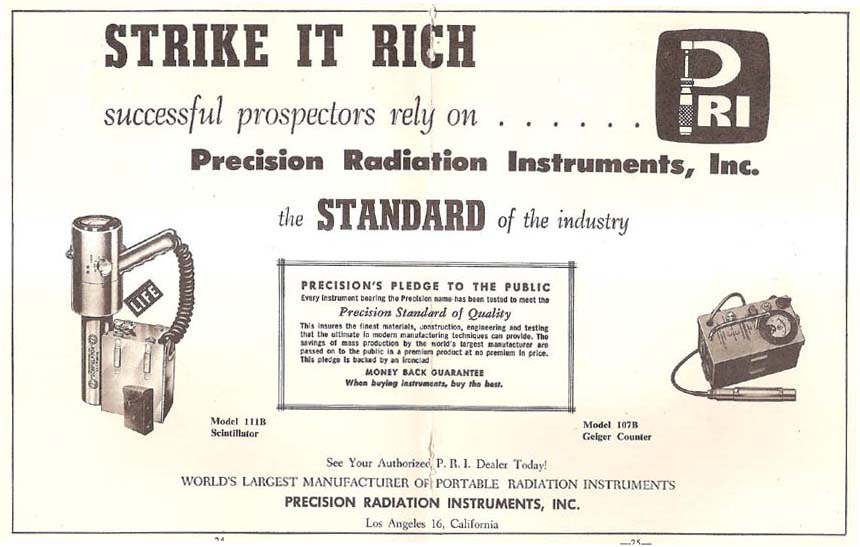
PRI Model 111B 1955
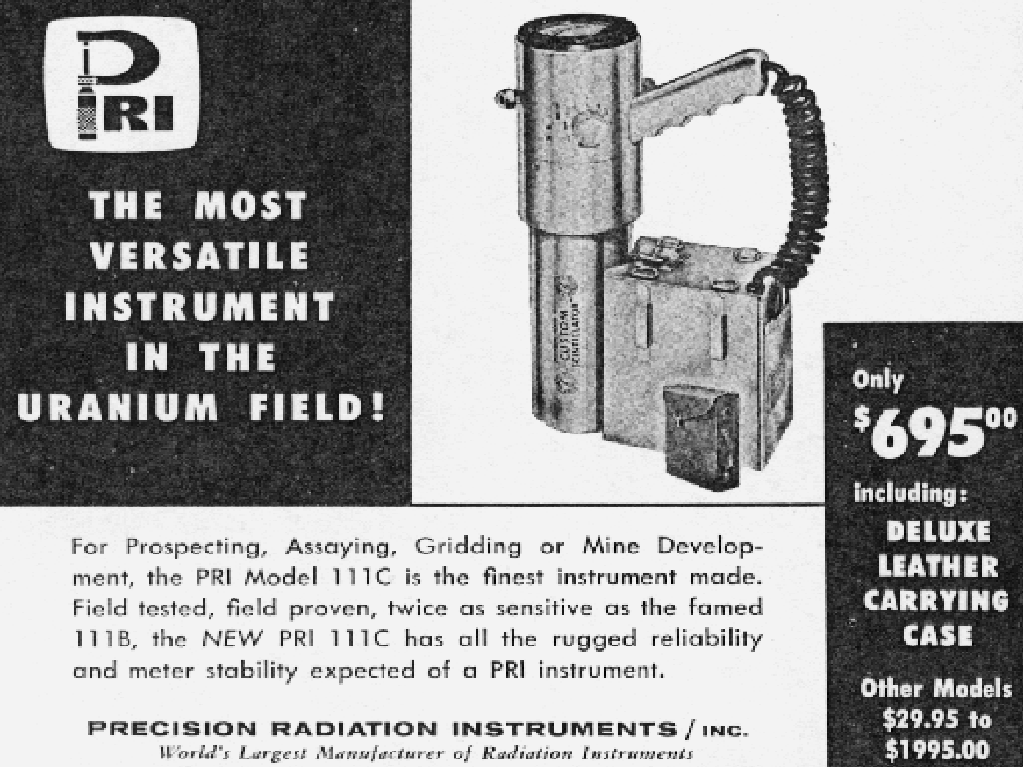
PRI Model 111C 1955
The Royal Scintillator was initially introduced in 1947. The unit is a scintillator probe with accompanying control unit in a briefcase. An improved version of the unit was still be offered in 1955. The advertisement asked “Why Search for Uranium with a Horse and Buggy?” These larger format detectors were still portable but bulkier and heavier, partly due to the large size scintillation detector and batteries. In addition, the instrument had such a large detector crystal size that it could be used for Aerial Prospecting for uranium.
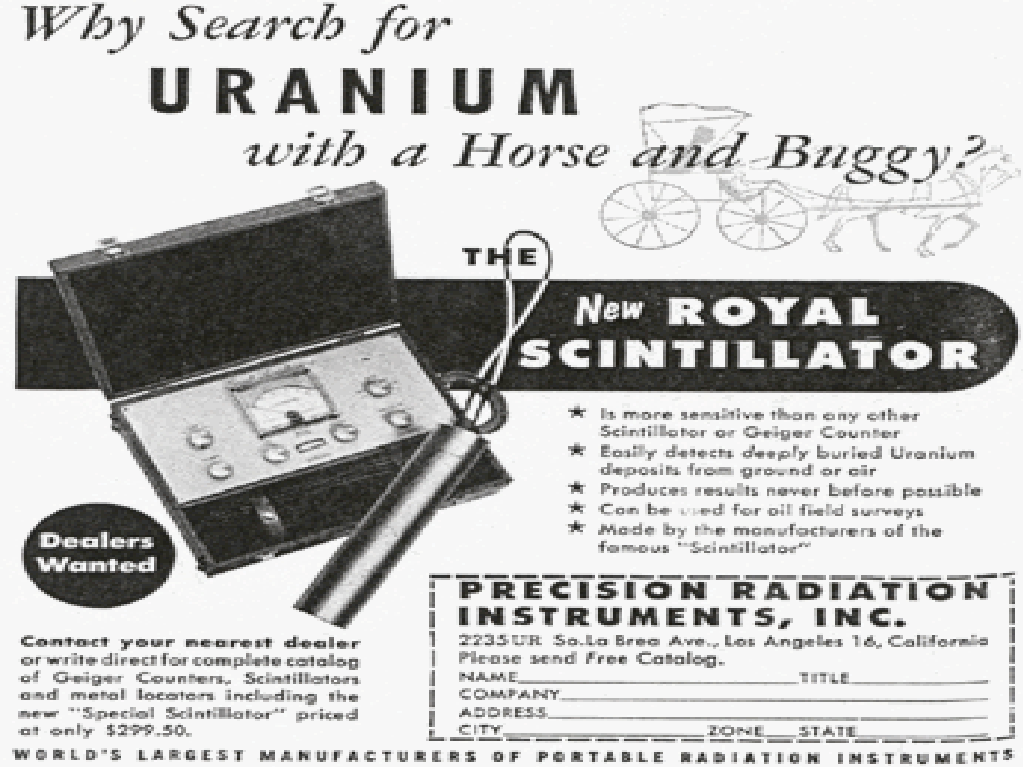
PRI Royal Scintillator Model 118 Ad 1955
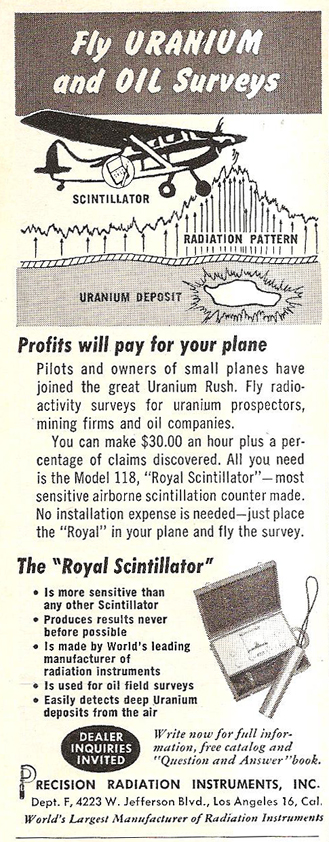
PRI Royal Scintillator Model 118 Ad for Aerial Prospecting 1955
In contrast, manufactures such as El-Tronics were also producing small, compact geiger counters including the Ura-Finder from the 1950's shown below. The Ura-Finder was a pocket-sized unit which could be used to just testing various rocks to see if they were radioactive. The ad states "Now! Uranium Prospecting Easier Than Ever Before - Pocket Size Geiger Counter.
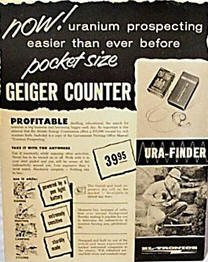
El-Tronics Ura-Finder Ad 1950's
Universal Atomics produced a line of transistorized geiger counters in the mid-1950's, including the instruments with long extension probes and gun formats. The long extension probe instruments allow the prospector to carry the electronics and batteries in a shoulder strap case and use the extension probe with the detector on the end to probe cracks and crevices which might reveal uranium ore veins. The ad states "Now! For The First Time Since the Discovery of Uranium - Miracle Geiger Counters".
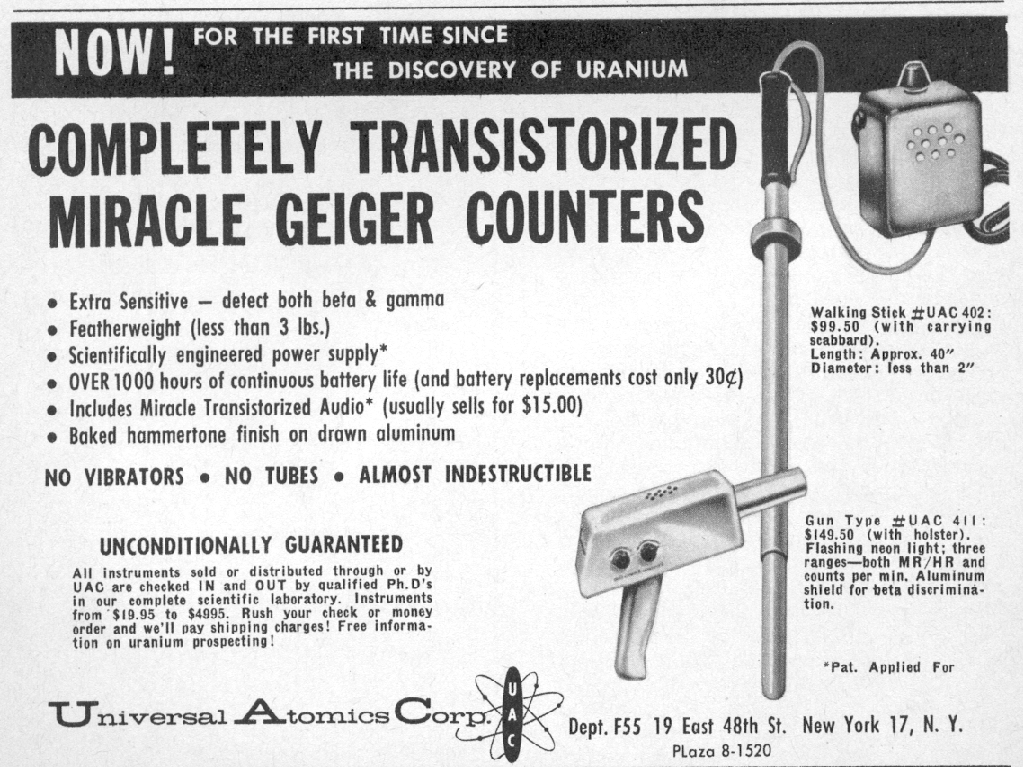
Universal Atomics Corporation Ad 1955
The Gamma Gun by Universal Atomics was a more sensitive instrument, weighted 6.5 lbs and sold for $995. It came in the popular easy to hold gun type format.
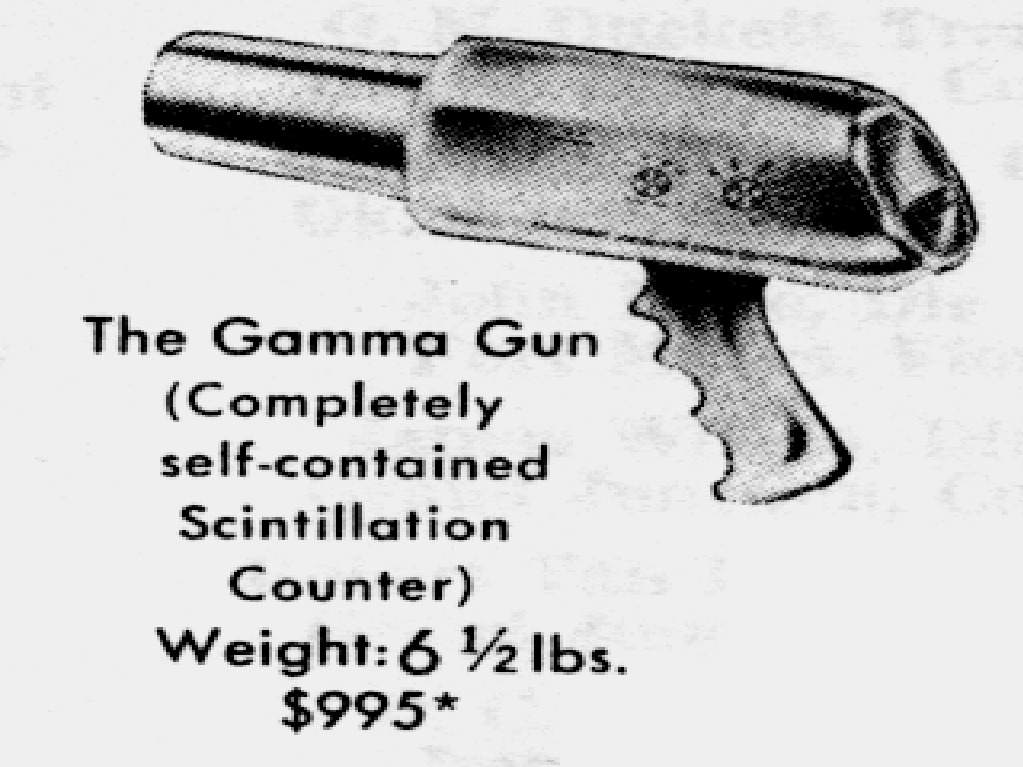
UAC Model Gamma Gun 1956
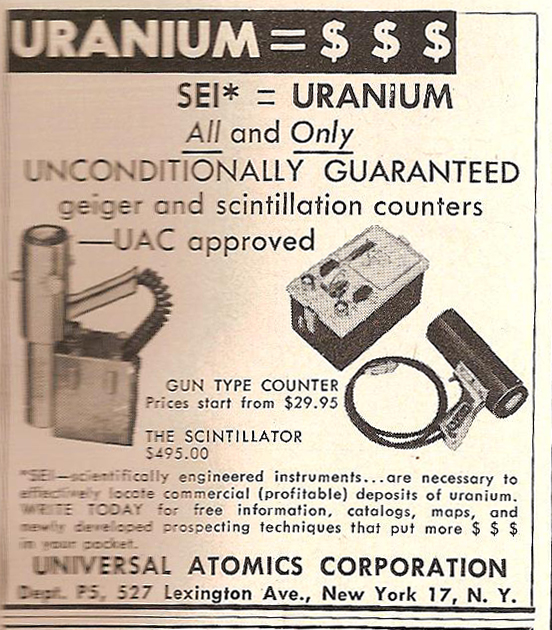
Universal Atomics Ad 1955
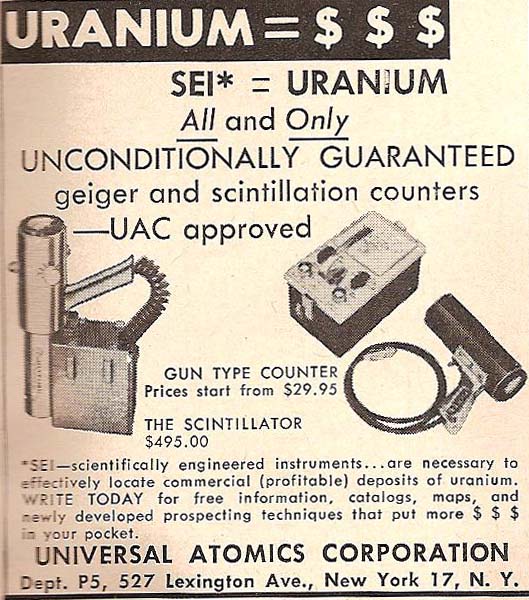
Universal Atomics Ad 1955
Radiometric Instruments produced Geiger Gun as shown in the figure below with a gun shape. It weighs less than 1 lb. with batteries. It is completely transistorized with a bismuth tube. A simple pull trigger-switch automatically recalibrates the instrument so that the reading gives direct percentage uranium oxide. The unit sold for $179.50 in 1956.
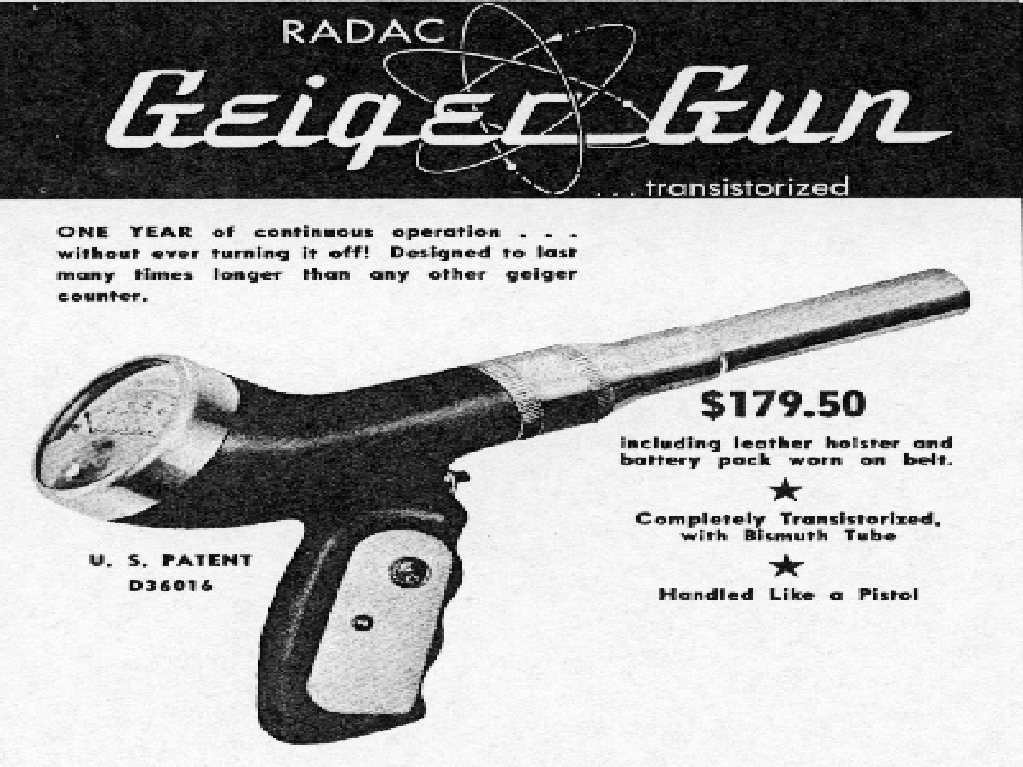
Radiometric Instruments Geiger Gun 1956
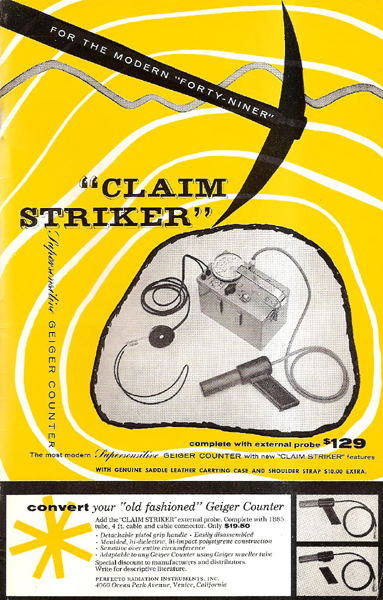
Perfector Radiation Instruments Claim Striker Ad 1955
Goldak introduced the Scinta-Ray in 1955. The unit employs a scintillation detector and came in the more familiar handle on top type meter. It was advertised for field, vehicle and airborne use. It sold for $389.50.

Goldak Scinta-Ray Model 203 Ad 1955
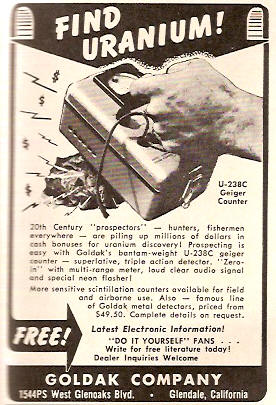
Goldak Model U-238C Geiger Counter Ad 1955
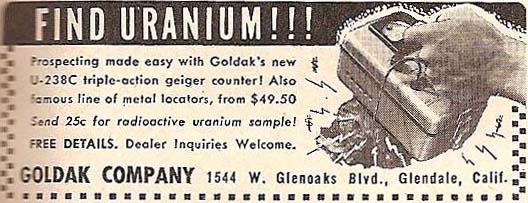
Goldak Model U-238C Geiger Counter Ad 1955
In the 1950's, there were many companies producing build your old Geiger counter as a way to lower the price. Each kit came with the parts and instructions for the "Do It Yourself Kit". By assembling the unit yourself, one could buy instrument kits for as low as $15. The following three ads are examples of Geiger counter kit advertisements.

C & H Sales Company Ad 1955
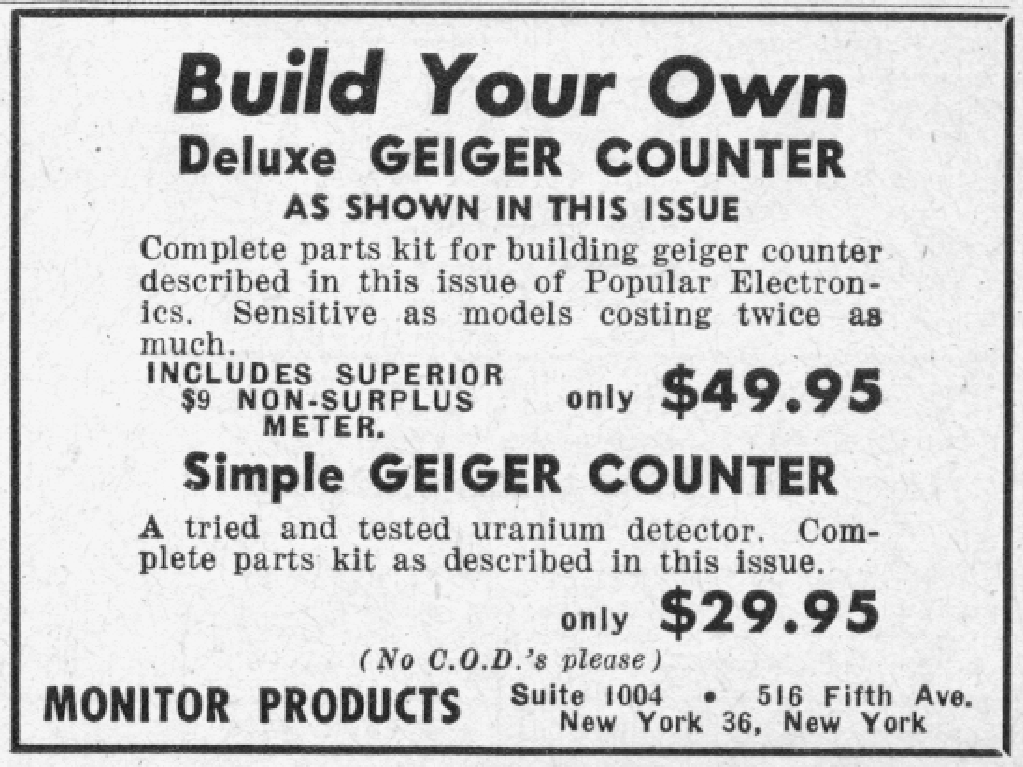
Popular science Ad for Monitor Products 1955
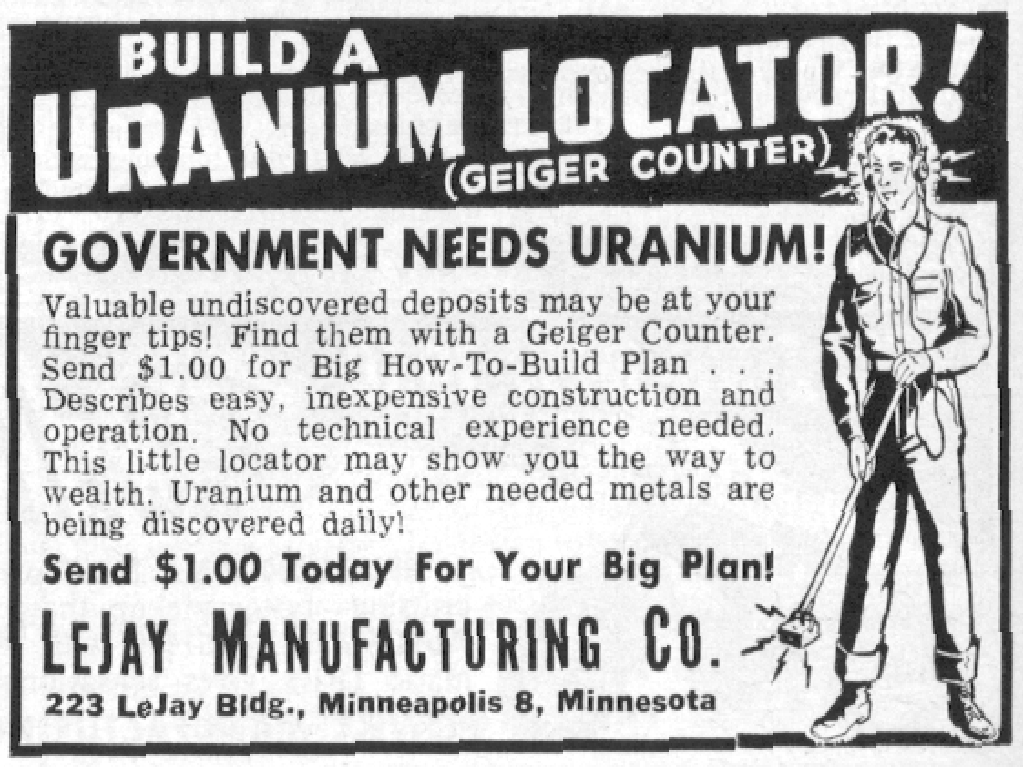
Popular Science Ad for LeJay Manufacturing 1950
In 1957, Popular Mechanics magazine offered the “Prospector’s Partner”, a combination Geiger-counter portable radio. It was a kit you could build on your own and the article had complete plans, parts lists and wiring schematics. It was designed to be built into a standard size radio case.
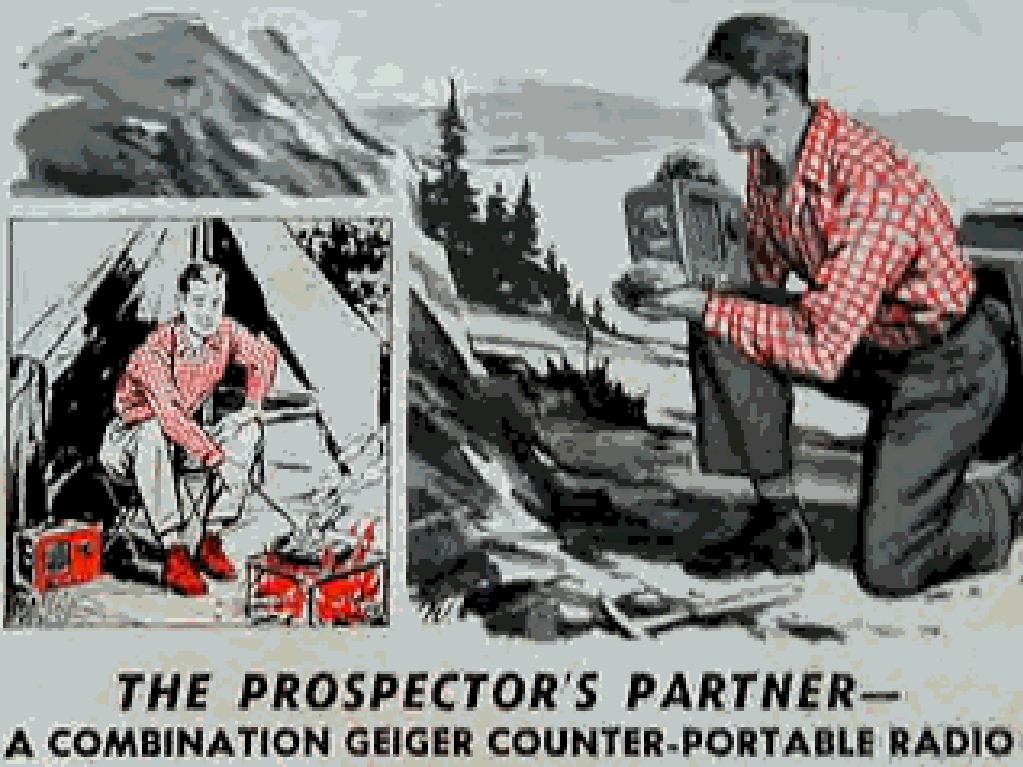
Camping with a Geiger Counter Radio 1957
The Radiac Company was a major distributor of radiation detection equipment. All of the Radiac Company product line was produced by other radiation detection manufacturers. One example is the Sniffer, a compact, portable instrument that easily fit in your hand. The ad stated "Discover Uranium - Win Huge U.S. Gov't. Cash Awards - Locate Radioactive Ores with The Sniffer". The company was very good at advertising and providing very clever names to their product line that attracted the reader.
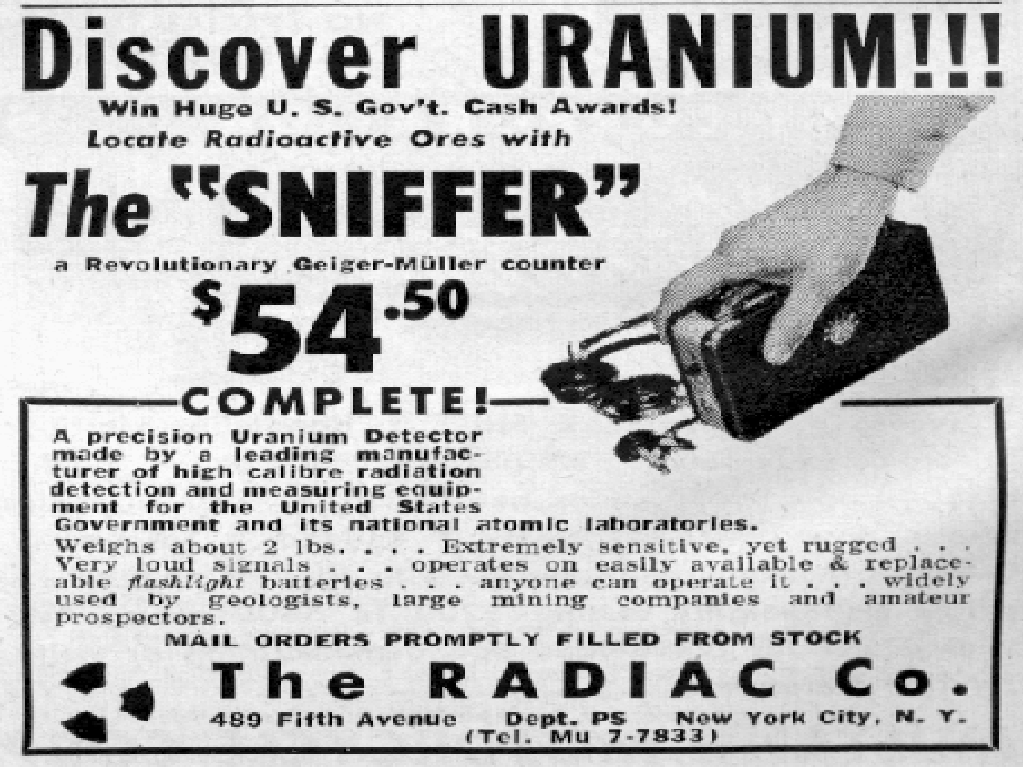
Popular Science Ad for The Radiac Company 1949
One of the more interesting product lines was from White's Electronics, which produced the Oremaster series in the 1950.s The ad below states "Strike it Rich with Oremaster's Rockhound Super Geiger Counter". The instruments provided higher sensitivity than normal geiger counters and a large 4.5" meter for ease of viewing.
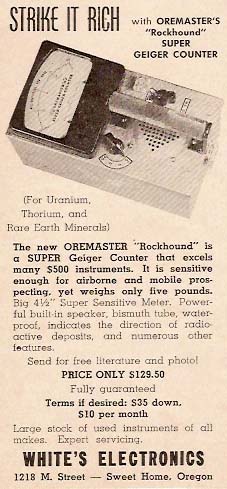
White's Oremaster Rockhound Super Geiger 1956
Victoreen produced undoubtedly the most extensive line of radiation instruments from the 1930's on. One example of a popular instrument from the 1950's was the Vic-Tic which could be used to "Find a Fortune on Vacation, Hunting and Fishing Trips - Pin-Point Uranium". It came in a very shiny gold and bright red colors.
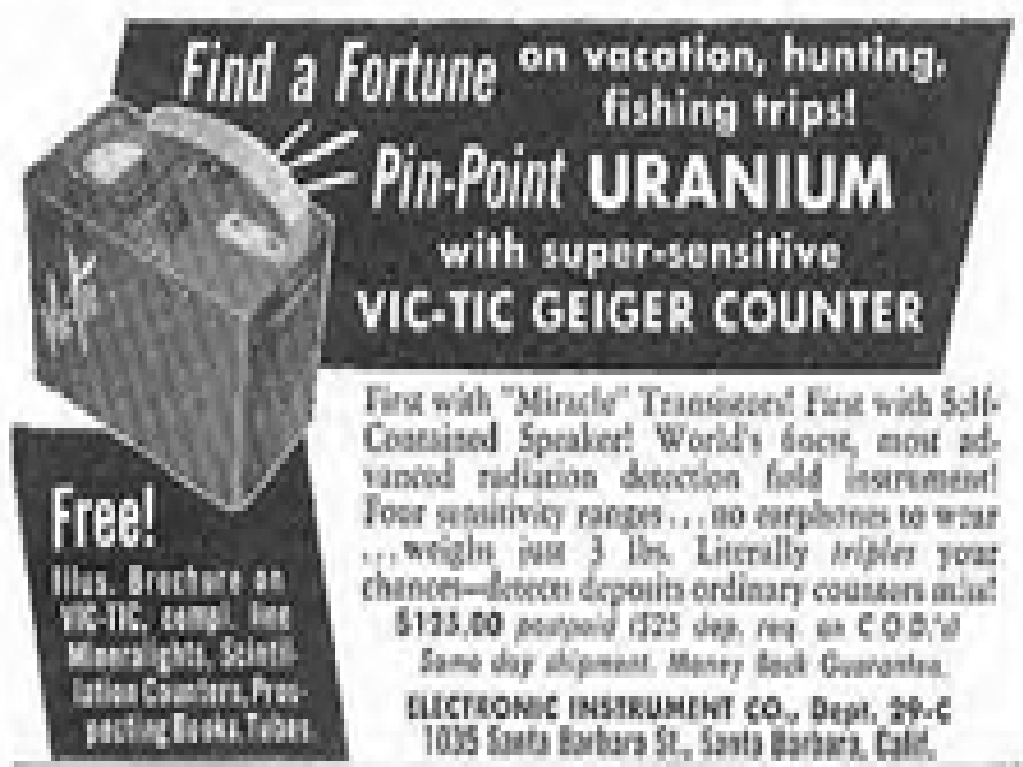
Victoreen Vic-Tic Ad 1955
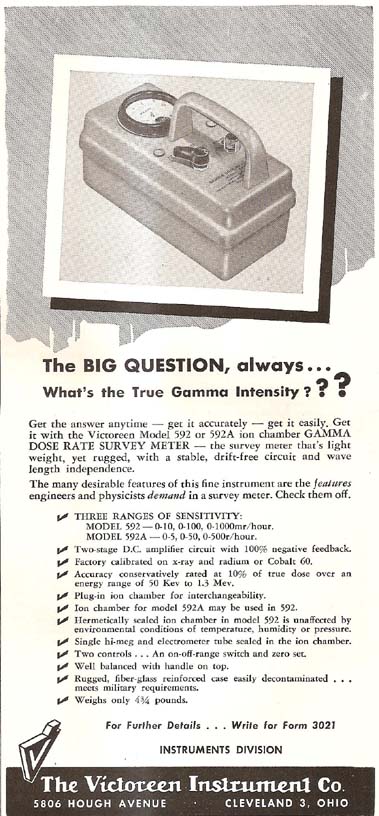
Victoreen Vic-Tic Ad 1955
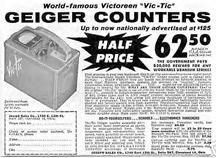
Victoreen Vic-Tic Ad 1956
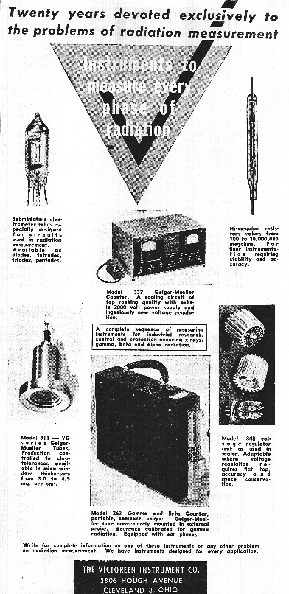
Victoreen Ad with Model 263 1947
Another product of Victoreen was the amazing Scintigeiger in 1956, which was a combination scintillation counter and geiger counter. It claimed to be able to discriminate between uranium and thorium. The unit sold for $575, a price more in line with the serious prospector.
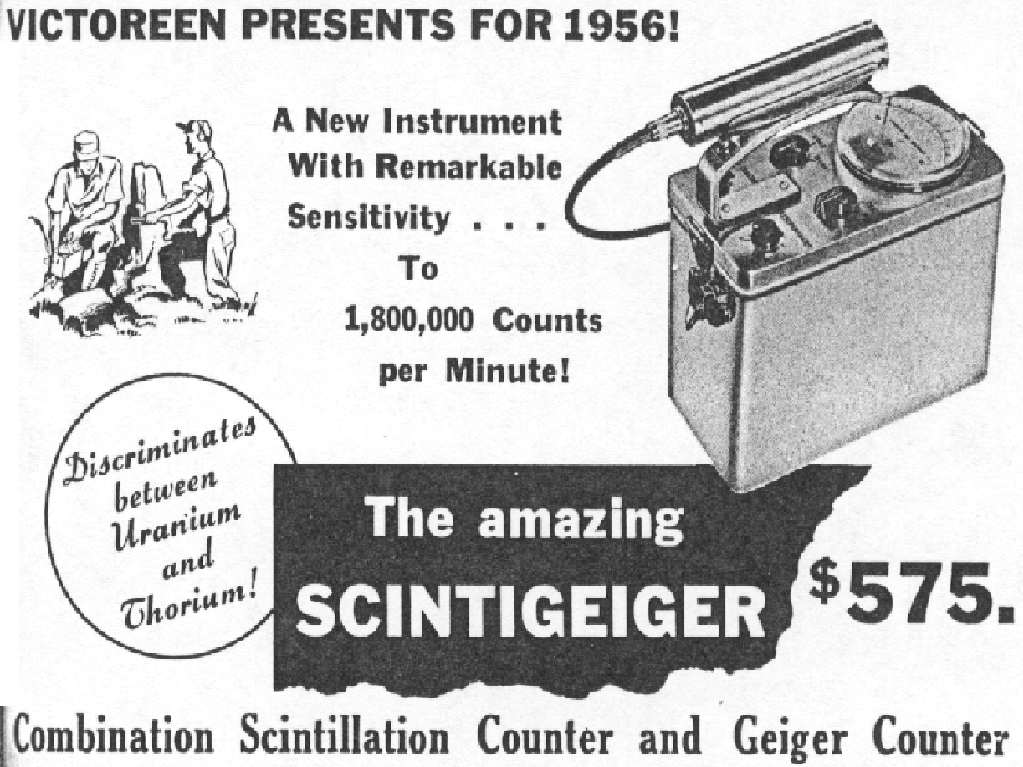
Victoreen Scintigeiger 1956
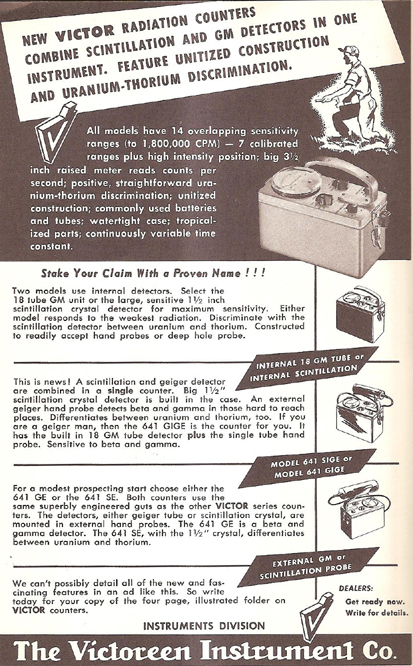
Victoreen Geiger Counter Ad 1955
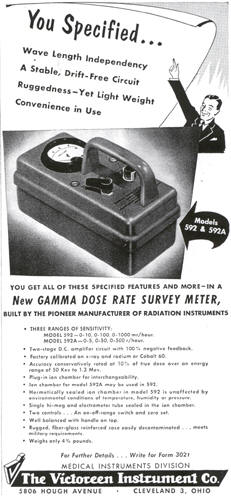
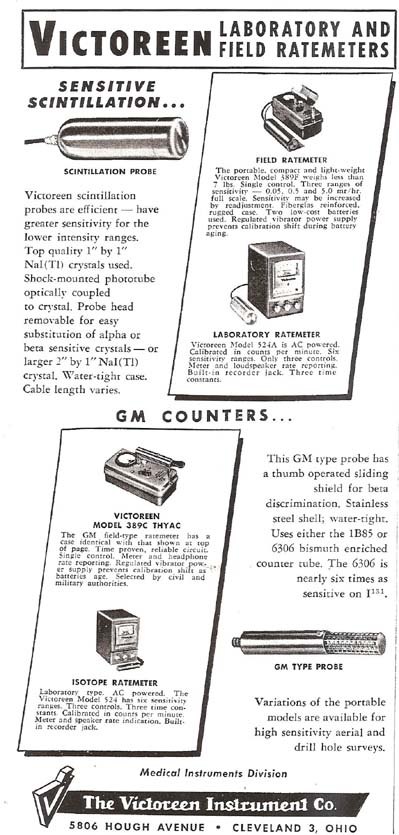
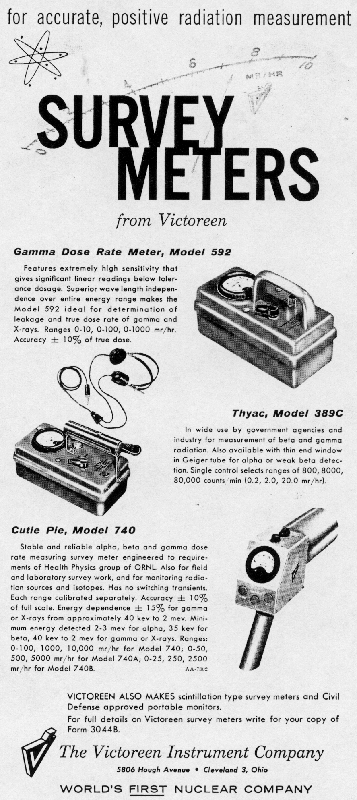
Victoreen Ads 1954 to 1958
Atomic Instruments Company produced the Model 414 Radiation Survey Meter in 1956. It was a Cutie Pie style meter with a pistol grip and front nose ionization chamber. The instrument could be used for a wide range of applications for both the field and laboratory.
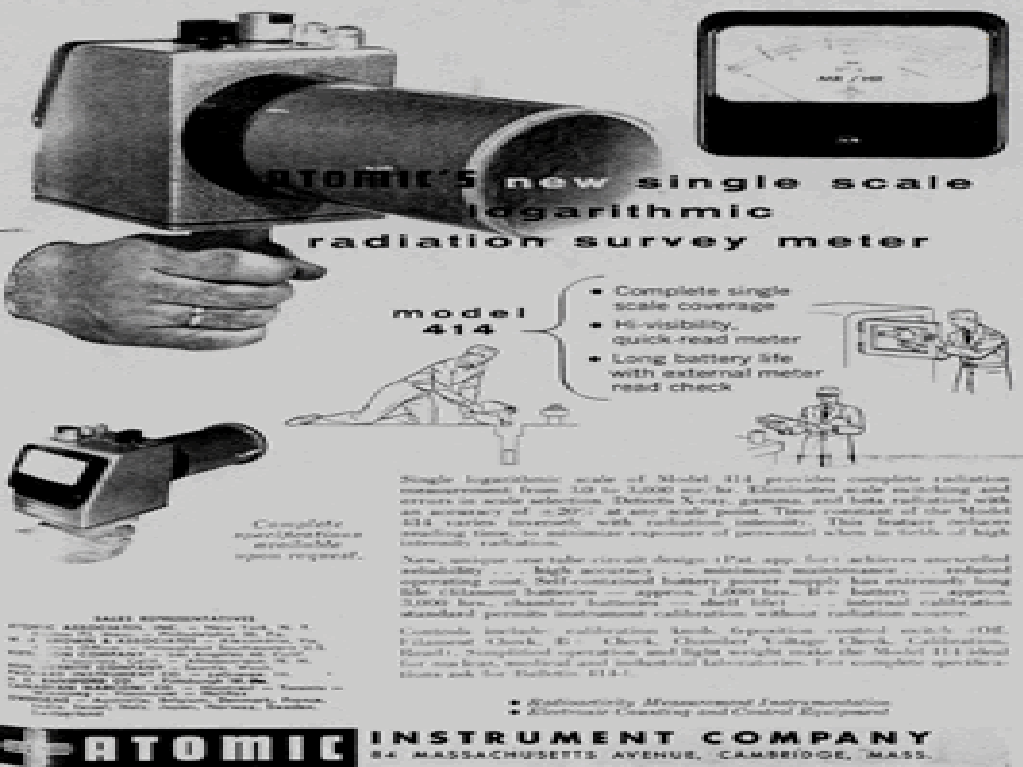
Atomic Instrument Model 414 Ad 1956
Sears and Roebuck offered the Tower line of radiation instruments in their catalogs during most of the 1950's. The manufacturer was El-Tronics which also had a similar product line. An example of the Model 6161 Scintillation Counter is shown below, a Cutie Pie style instrument with a highly sensivite sodium iodide detector in the nose of the unit. It sold for $495.
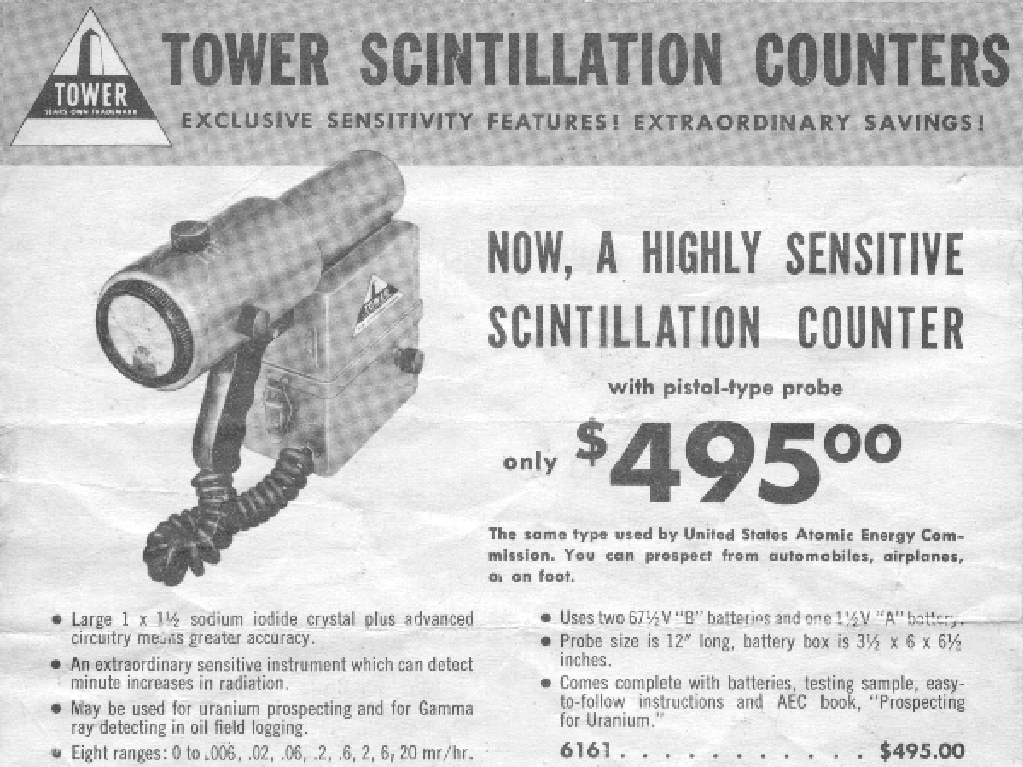
Sears Tower Model 6161 Ad 1955
Technical Associates introduced the Juno in the mid-1950's as an instrument for Health Physicists. The unit had a shiny aluminum finish for ease of decontamination and could detect alpha, beta and gamma using a series of bottom side screens which were controlled by a lever on the handle.
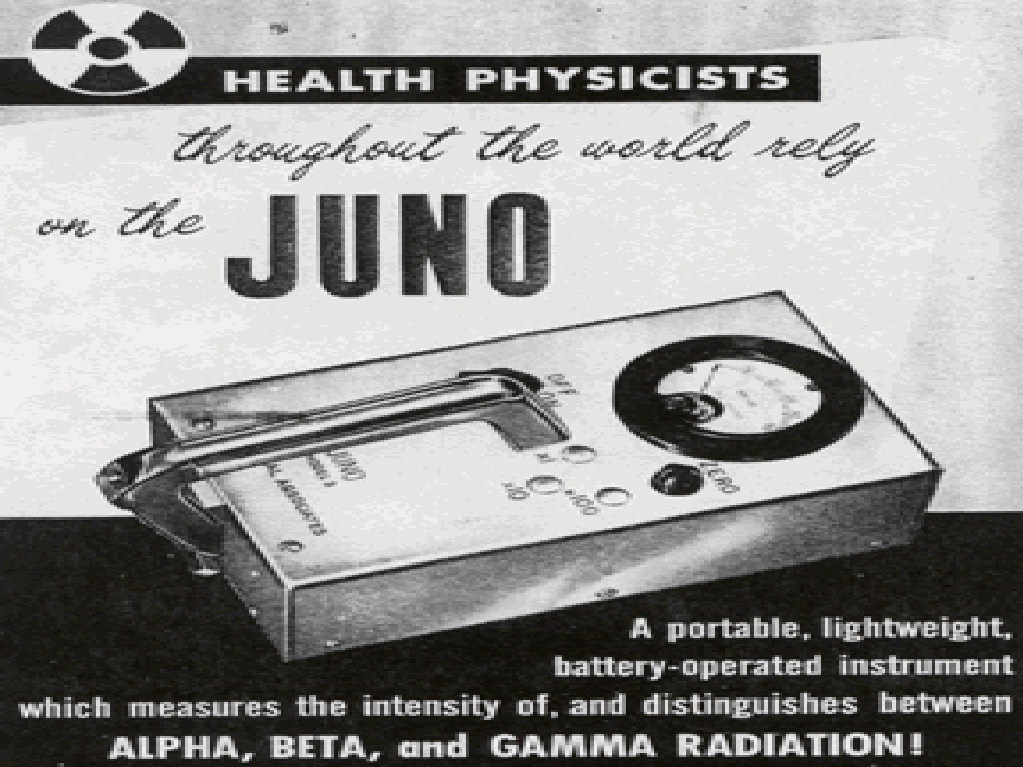
Technical Associates Juno Ad 1957
An example of one of the original style Cutie Pies is shown below for Technical Associates. It also was housed in a brushed aluminum casing for easy decontamination. This particular unit has a shield that could be placed over the nose to reject beta particles. Many versions of the Cutie Pie evolved over the 1950's.
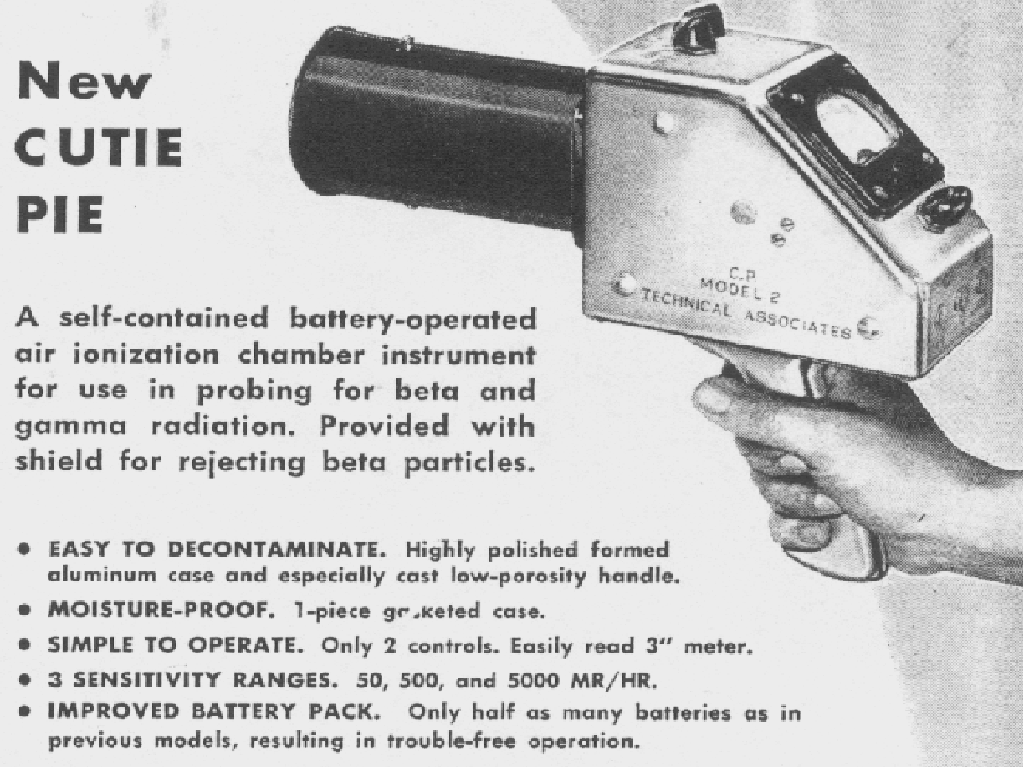
Technical Associates Cutie Pie Model CP-2 1953
Beckman's product line included the MX series for uranium prospecting as shown below. It was a low cost unit which was simple to operate with an on-off switch, long battery life, but employed only a set of headphones for audio tones. For prospecting, it was often difficult if not tedious to continuously look at a the needle movement on the meter and as such, the tones or clicks from a headset proved more popular.
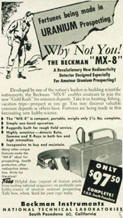
Beckman MX-8 Ad 1949
Stowers and Son produced an instrument called the Spotter, which provided a detachable probe. The probe could either be secured to the front of the instrument or detached and used for probing cracks and crevices with a five foot cable. The 1955 Spotter ad is shown below.
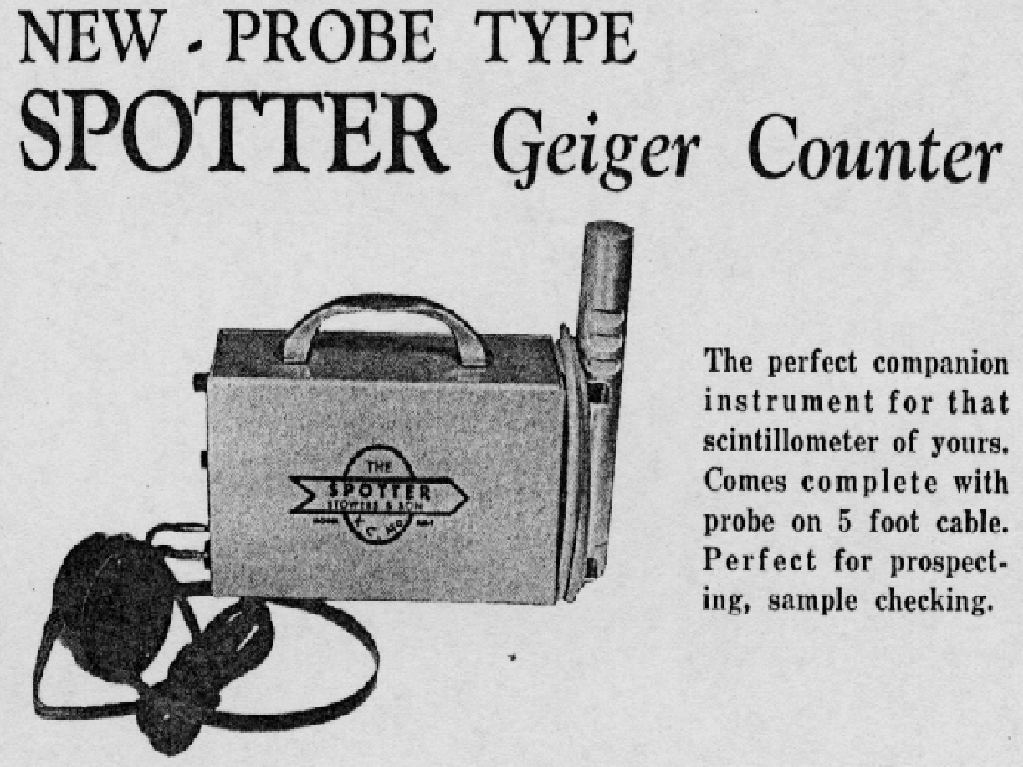
Stowers and Son Ad 1955
It wasn't just gamma detectors that were being developed. The emerging nuclear power industry also required neutron detectors. Radiation Counter Laboratories produced the transistorized fast-slow neutron survey meter in 1958 which sold for $775.
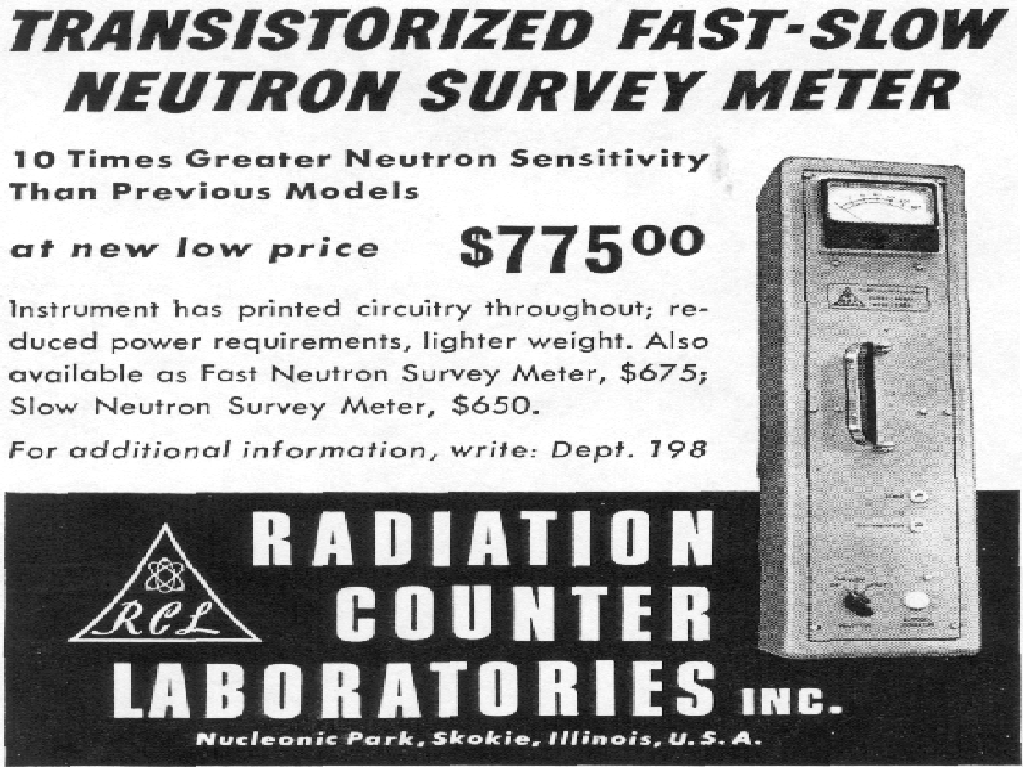
Radiation Counter Lab Ad Neutron Meter 1958
Another example of a Cutie Pie instrument was the Model 112 produced by Spinlab. The shape and size was more compact that the typical early Cutie Pies. The ad states that "Scientists Hail Latest Development in Lightweight Radiation Detector!
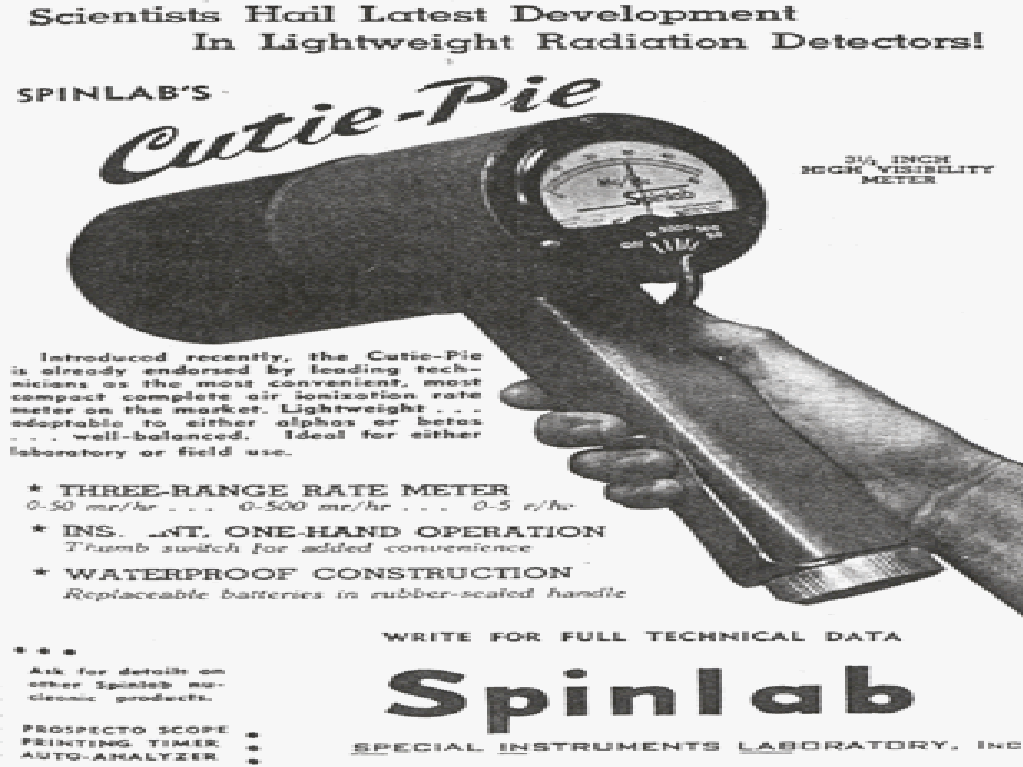
Spinlab Model 112 Cutie Pie Ad 1950
The Babbel counter series was very popular for down hole probing. The unit had a detachable probe that could be lower on a cable into a drill hole to measure radioactivity at various depths. This technique was used to try to locate veins of uranium ore before going to the expense of excavating. The Model 610 was "for those who demand the very finest".
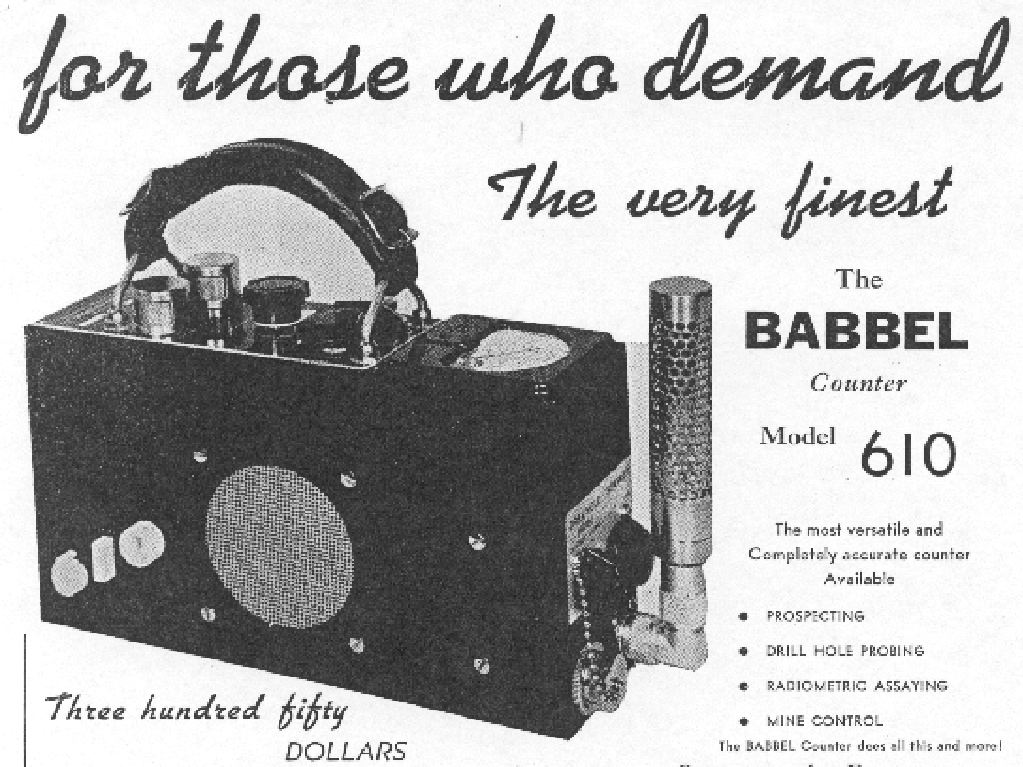
Babbel Counter Model 610 Ad 1955
Modern Living Electric was the unusual name for a Geiger counter company. With the new transistorized design and low power, a single set of batteries would almost last forever, the reports over 10,000 hours. They offered 3 models and the ad below shows a women in a bathing suit modeling with the Mark I Geiger counter.
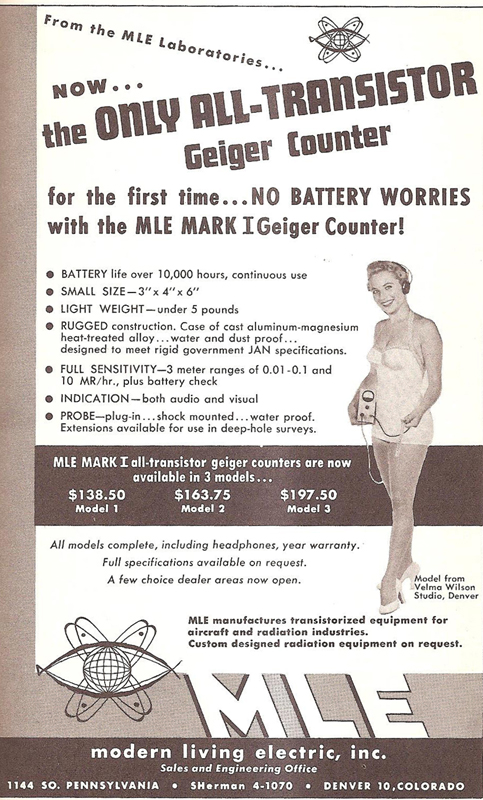
MLE Mark I Ad 1955
The Wedgie was offered in 1955. It was advertised as “The Scintillator Counter for Everyone”. The unit was a gun type with a detachable battery box. It came with the Scintillonics famous gun holster and weighed 6 lbs. It originally sold for $300.
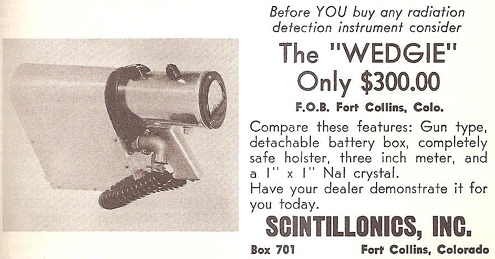
Scintillonics Wedgie 1955
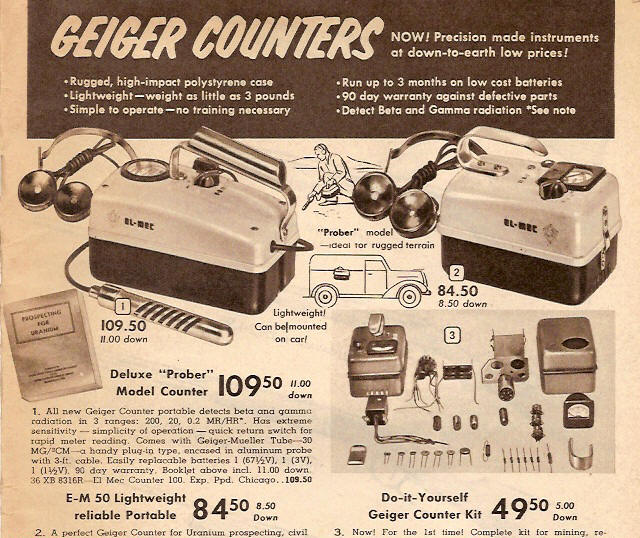
El Mec Model 50 and 100 1950's
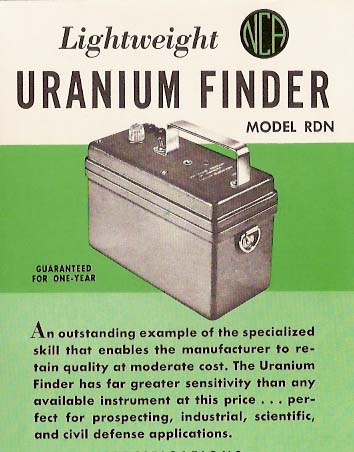
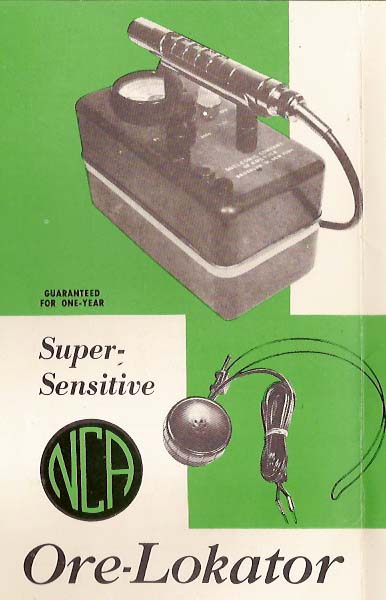
Nuclear Measurements Corporation Ads 1955
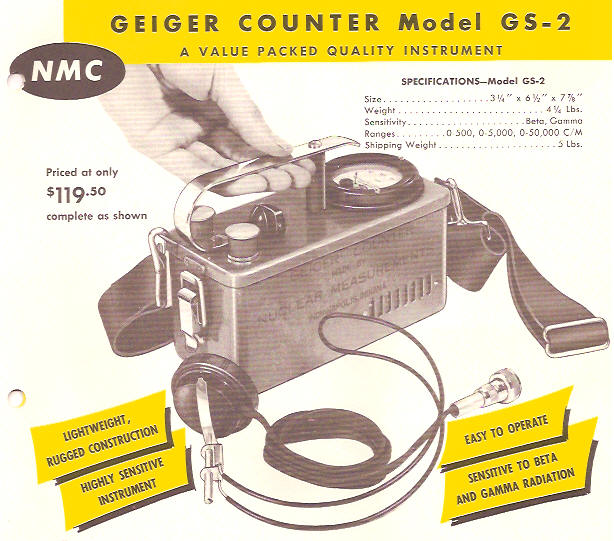
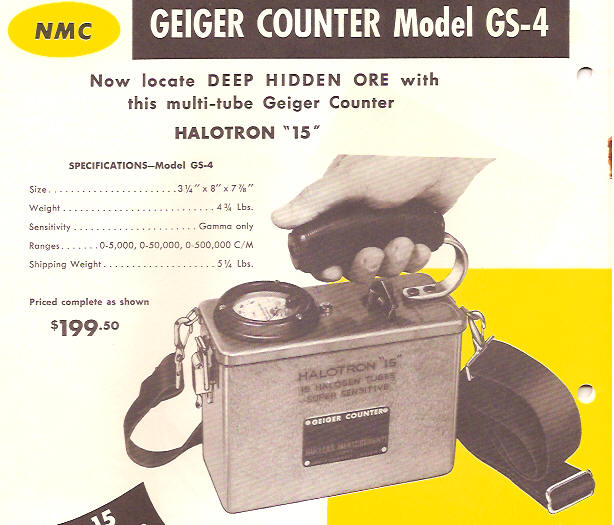
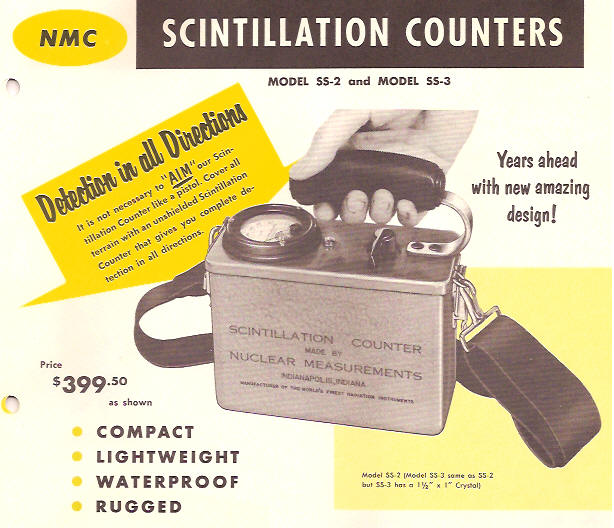
Nuclear Measurements Corporation Ads 1950's
Scientific Radio produced the Model S-101 Geiger Gun in 1955. The ad below shows the modern looking instrument with sold for $98.50.
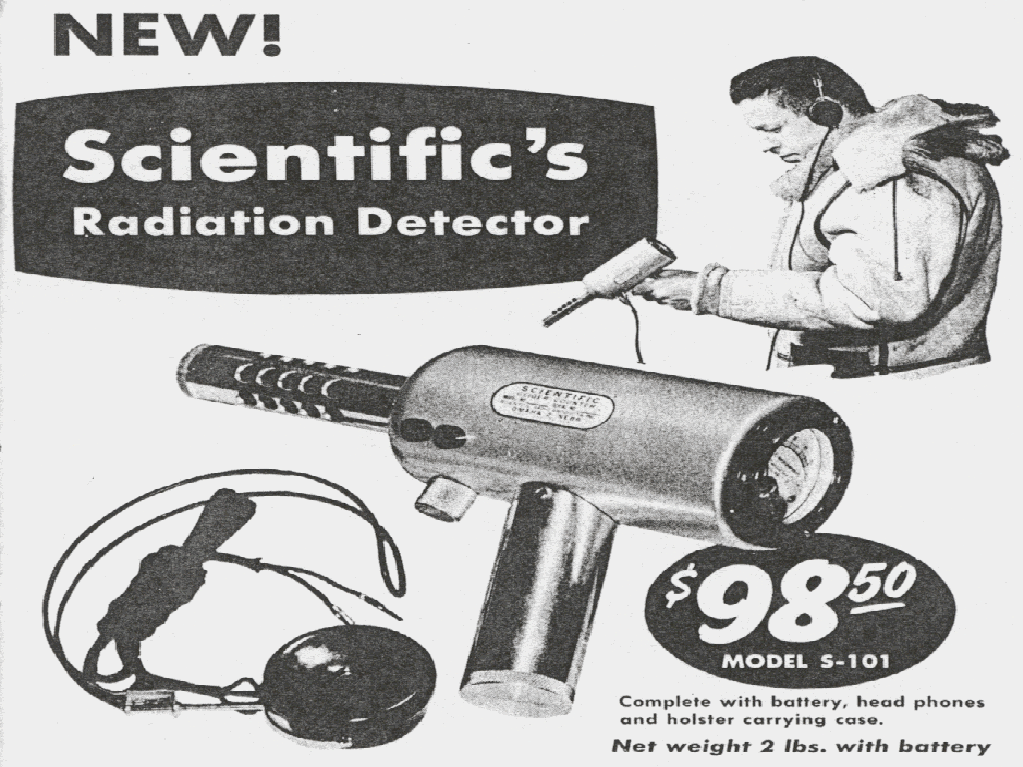
Scientific Radio S-101 Geiger Gun Ad 1955
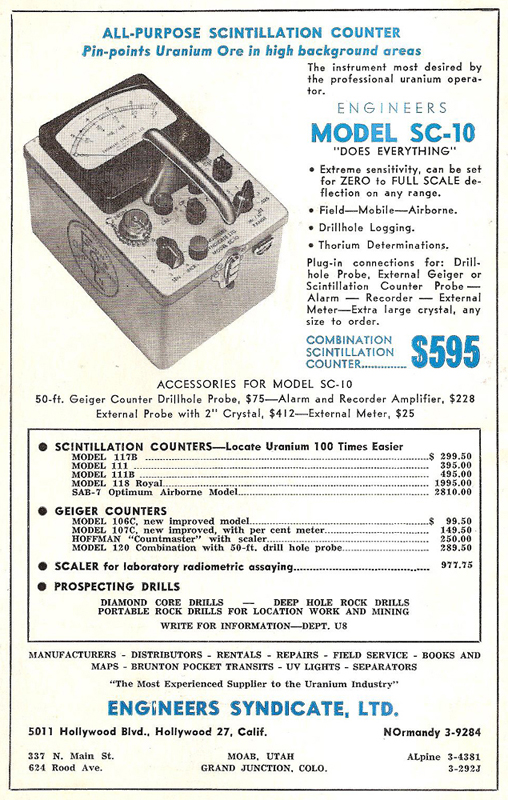
Engineers Syndicate Model SC-10 Ad 1955
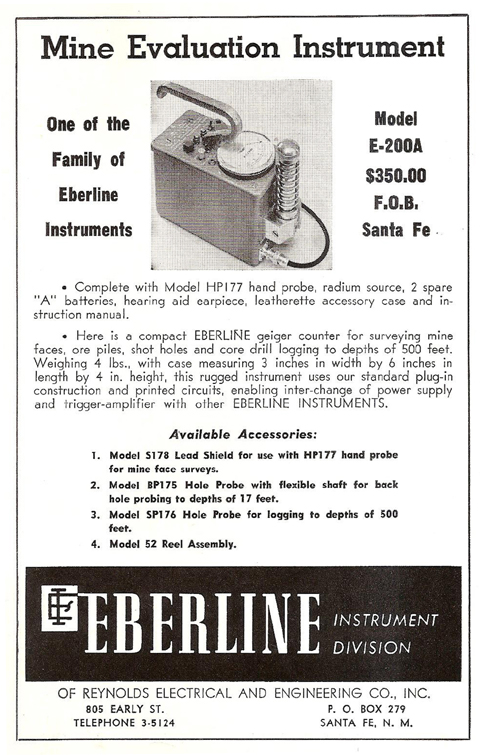
Eberline Mode HP177 Ad 1955

Fisher Scintilla-Dyne Ad 1955
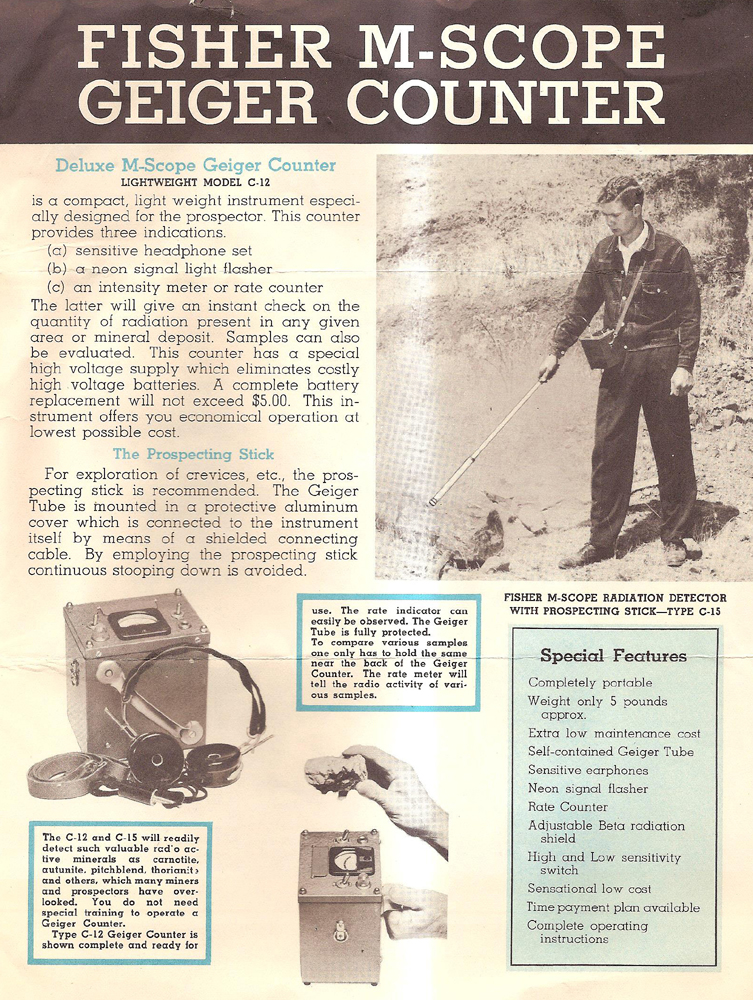
Fisher M-Scope Geiger Counter Ad 1950's
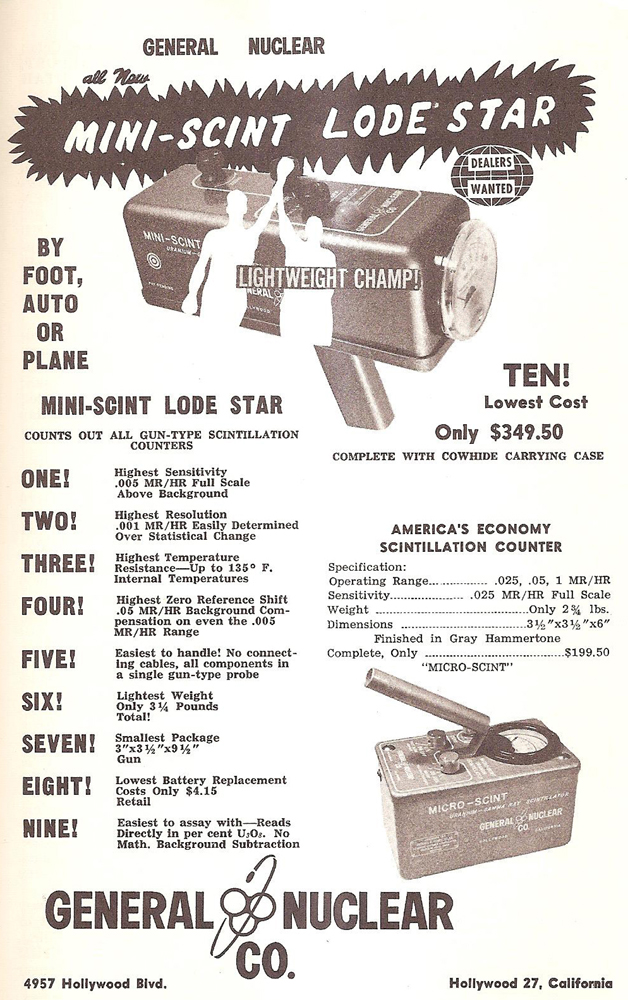
General Nuclear Mini-Scint Lode Star Ad 1955
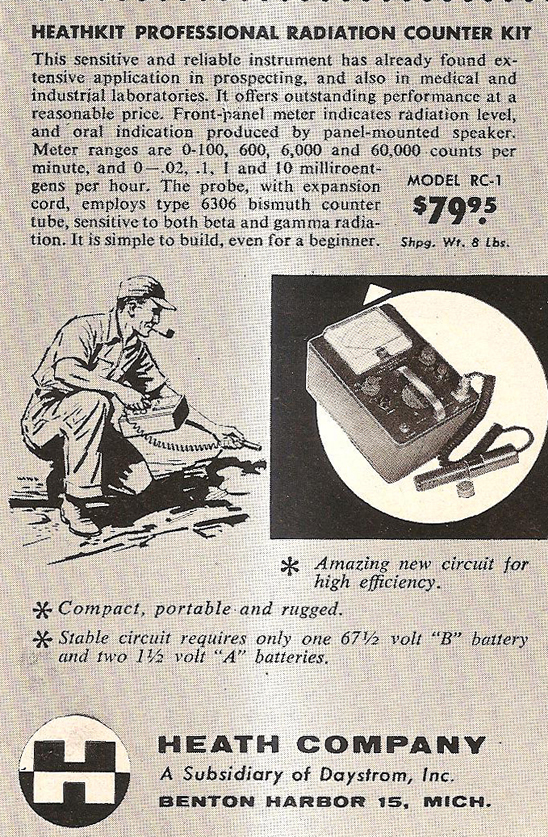
Heath Kit Professional Radiation Counter Kit Ad 1957
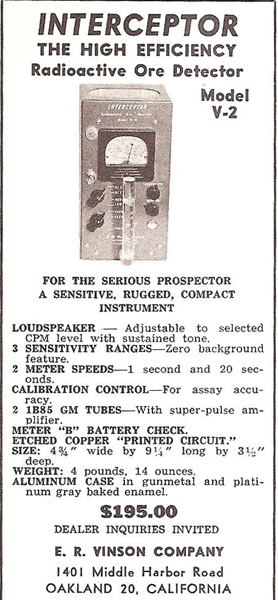
E.R. Vinson Intercepter Model V-2 Ad 1955
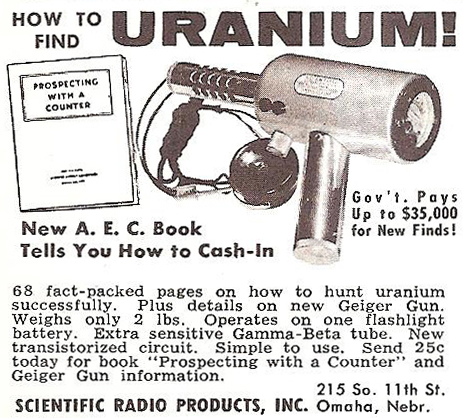
Scientific Radio Products Geiger Gun Ad 1955
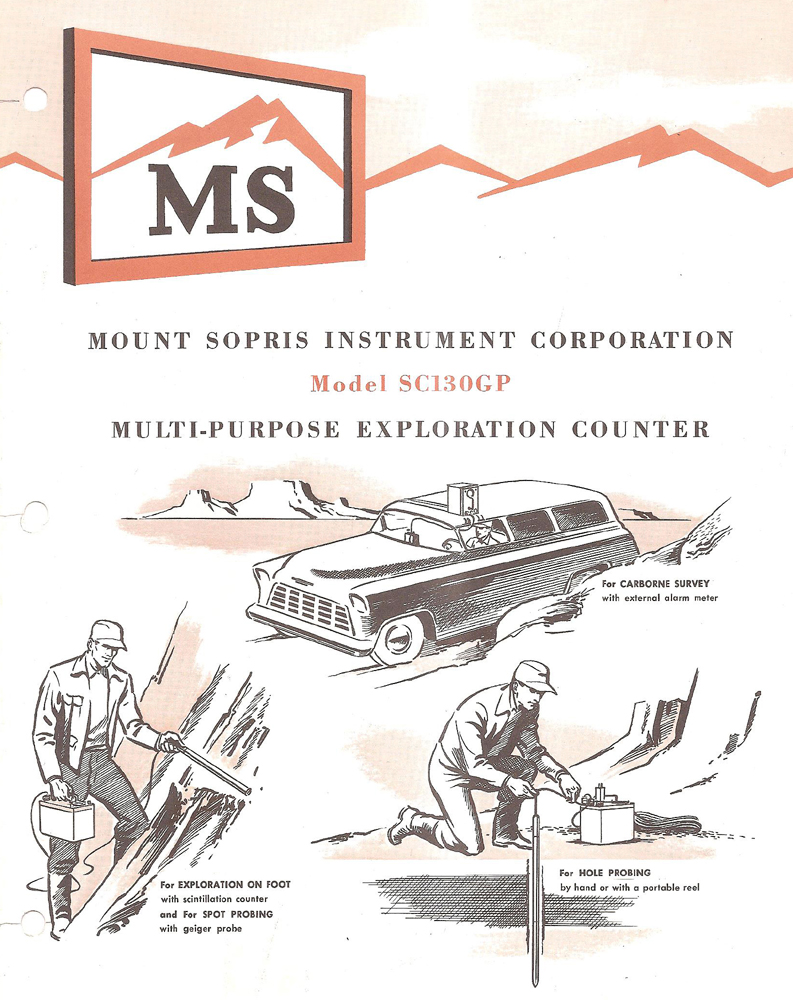
Mt. Sopris Model SC130GP Ad 1950's
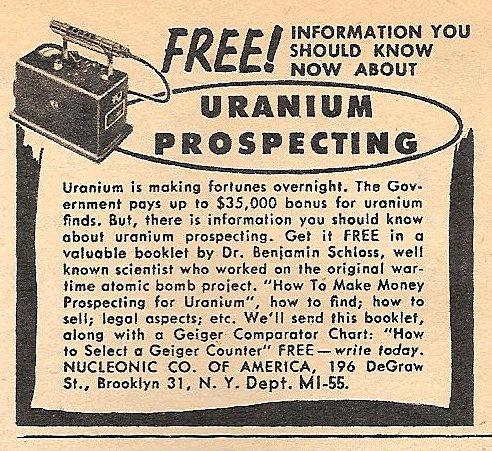
Nucleonic Company of America Ad 1955

Goldak Company Ad 1950's

PRI Ad in Popular Science 1955
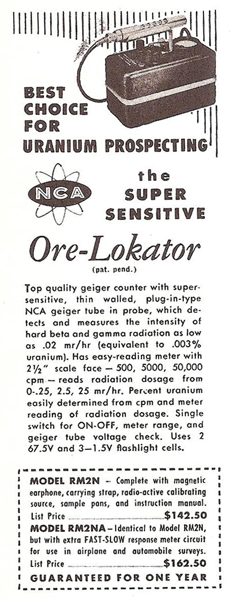
NCA Ore-Lokator Model RM2N Ad 1955
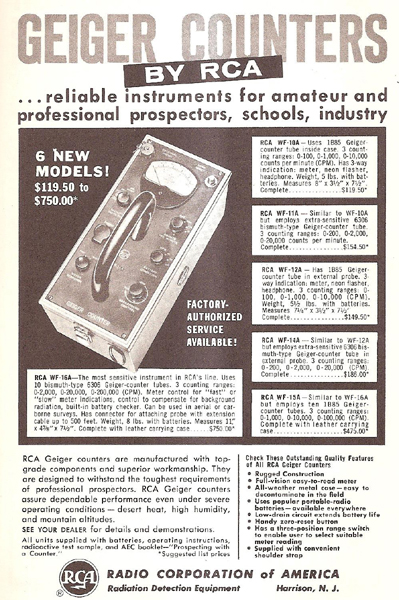
Radio Corporation of America Geiger Counter Ad 1955
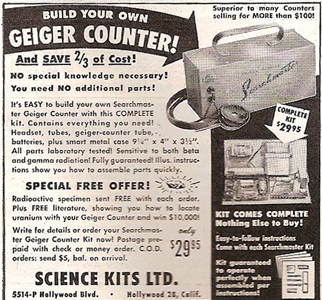
Science Kits Searchmaster Ad 1950
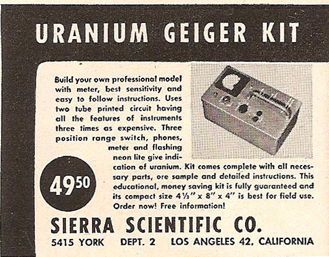
Sierra Scientific Uranium Geiger Counter Ad 1955
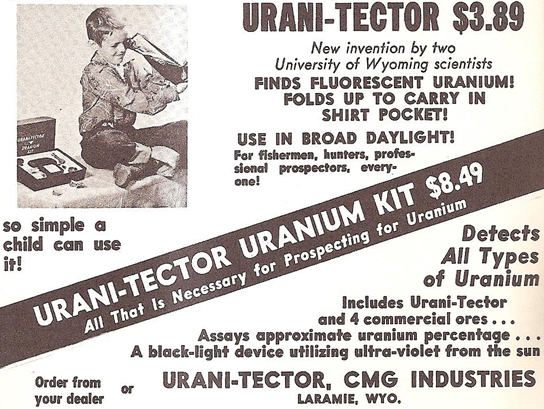
CMG Industries Urani-Tector Ad 1955
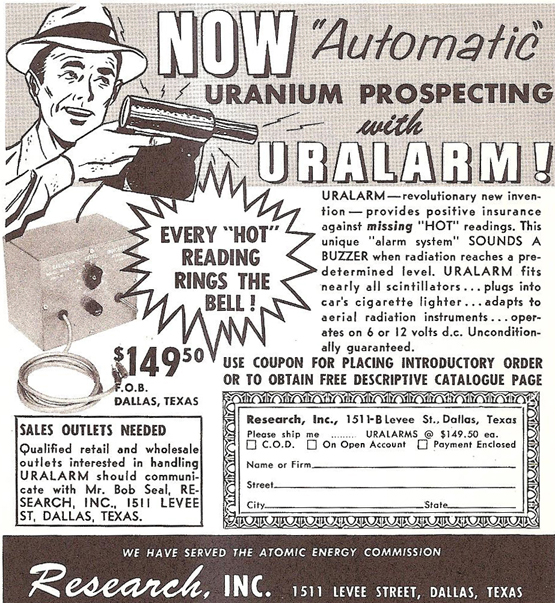
Research Inc. Uralarm Ad 1955
Sylvania introduced the Model 3401 in 1956 as a geiger counter with a radio. The ad below highlighted accomplishments by Women Engineers and show a women holding the new geiger counter. The unit came in a nice cowhide cover and shoulder strap.
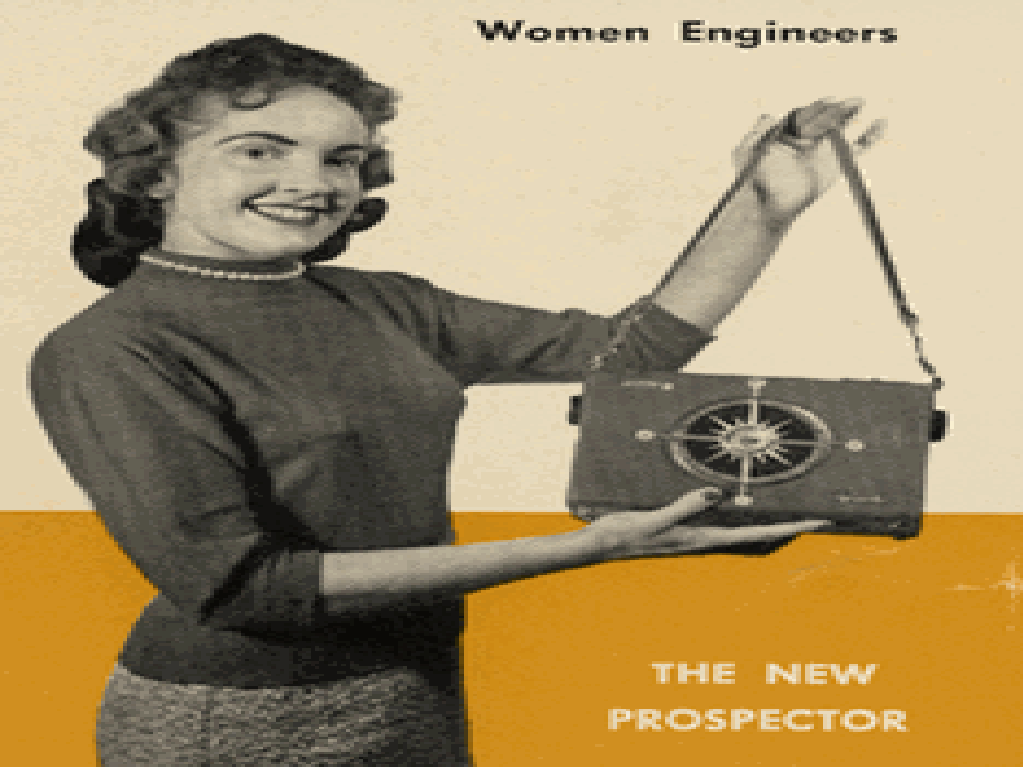
Sylvania Model 3401 Pamphlet Ad 1956
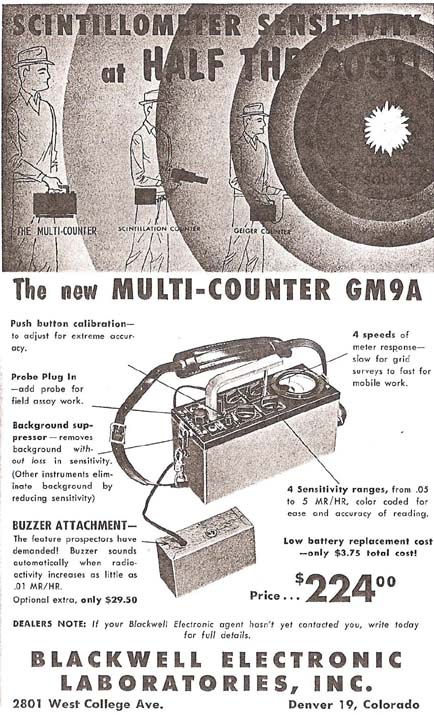
Blackwell Multi-Count Model GM9A Ad 1955
The ad below shows Keleket's Model K-352 Cutie Pie in 1950. The ad asks "What a Cutie Pie", and shows the detector but also a women sitting on the beach in a bathing suit under a palm tree.
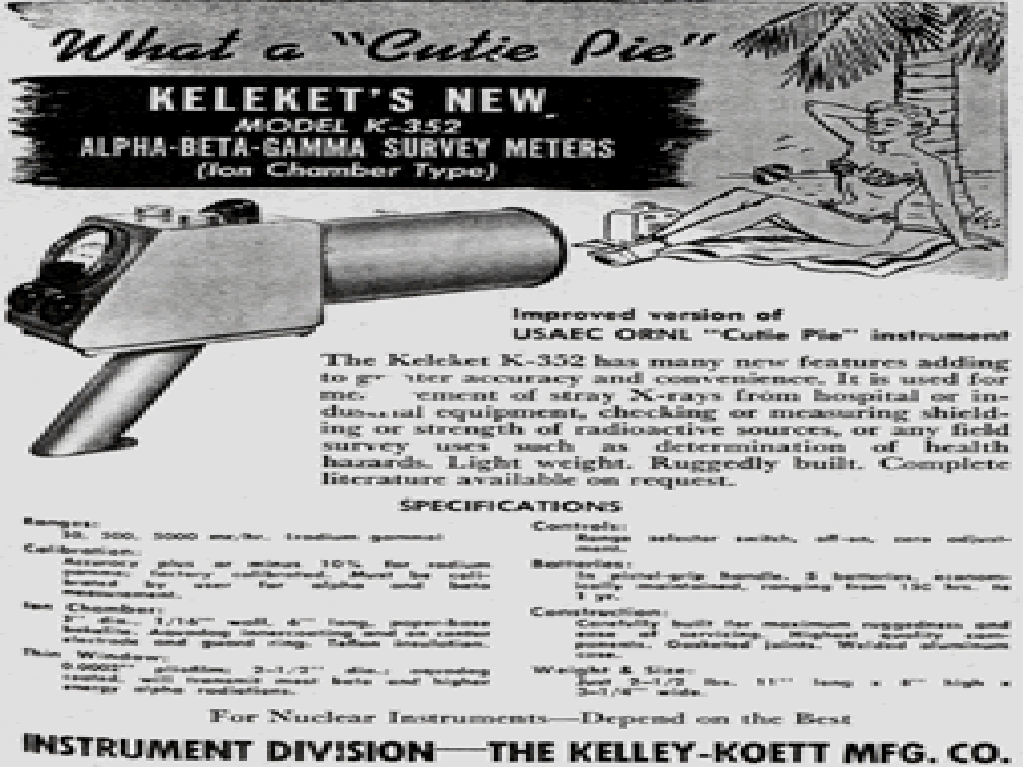
Keleket K-352 Cutie Pie Ad 1950
The R-Gun K-360 was offered in 1951. It was pistol shaped alpha, beta and gamma survey meter. The ad claims that Keleket has developed the majority of the radiation equipment being used by the military. The ad state "First Instrument designed and priced for Civil Defense". It comes with a holster. It sold for $69.50.
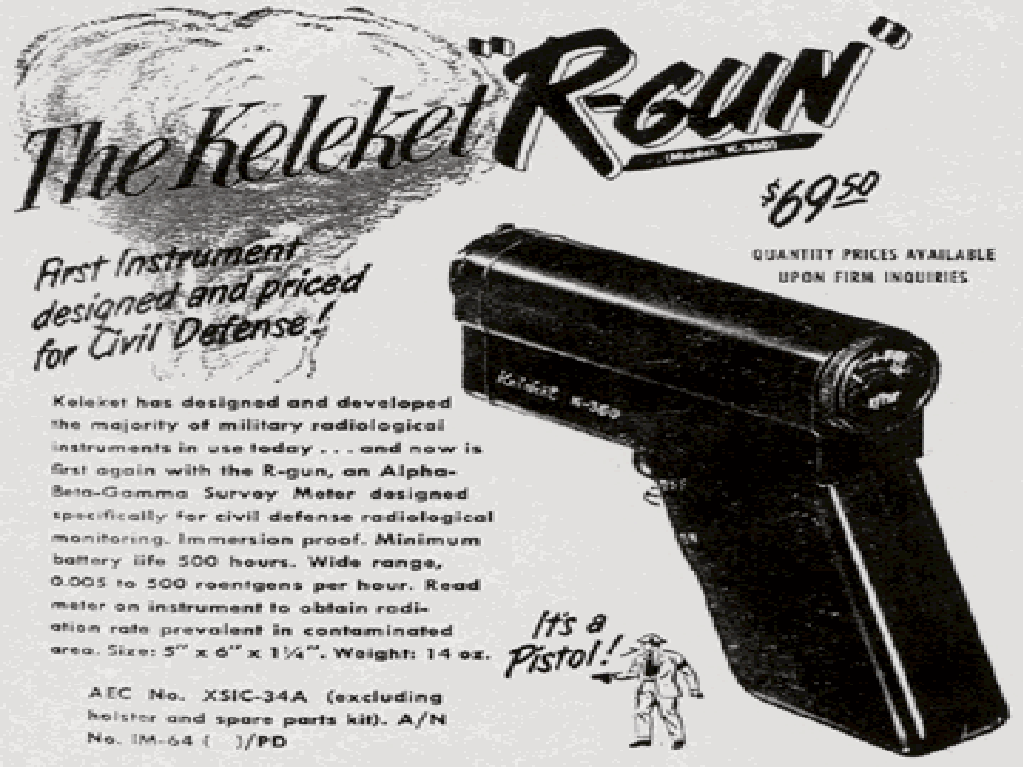
Kelekot K-360 R-Gun 1951
The Hoffman Model 216 Countmaster was the only Geiger counter with direct reading automatic scaler. The four decade scales could give a count up to 100,000. A “find” is flashed upon the four rows of neon lights until erased by the operator. Ore values could be determined instantly. It has a shielded, detachable probe for beta-gamma discrimination. It sold for $299.95 in 1954.
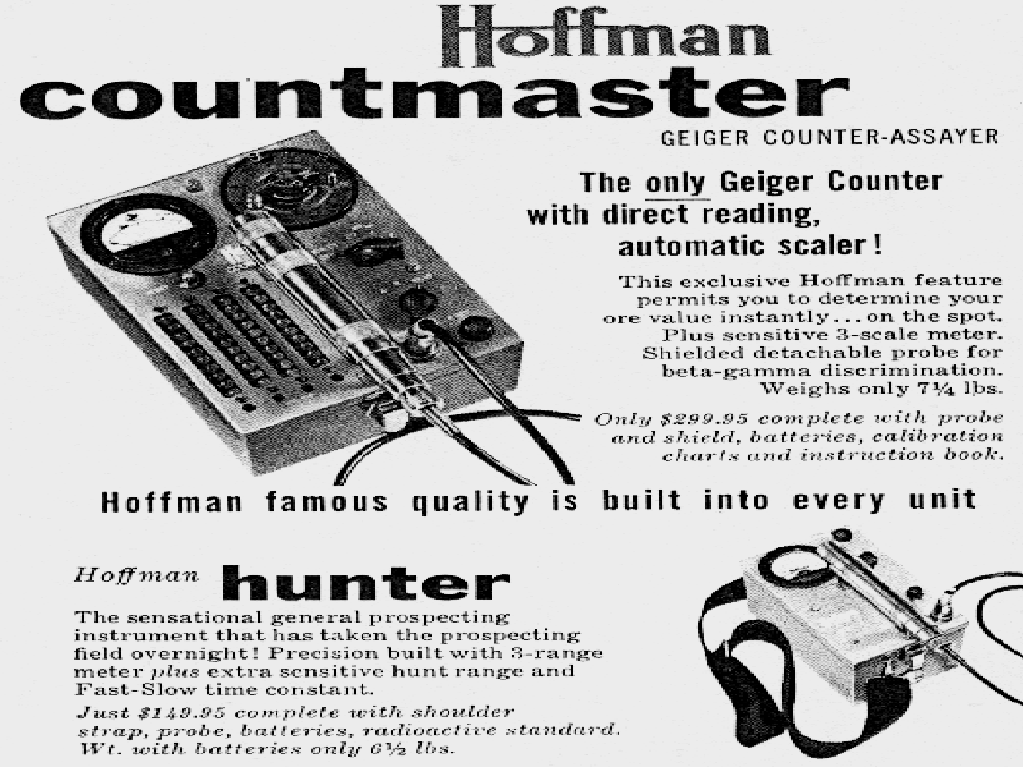
Hoffman Countmaster Ad 1956
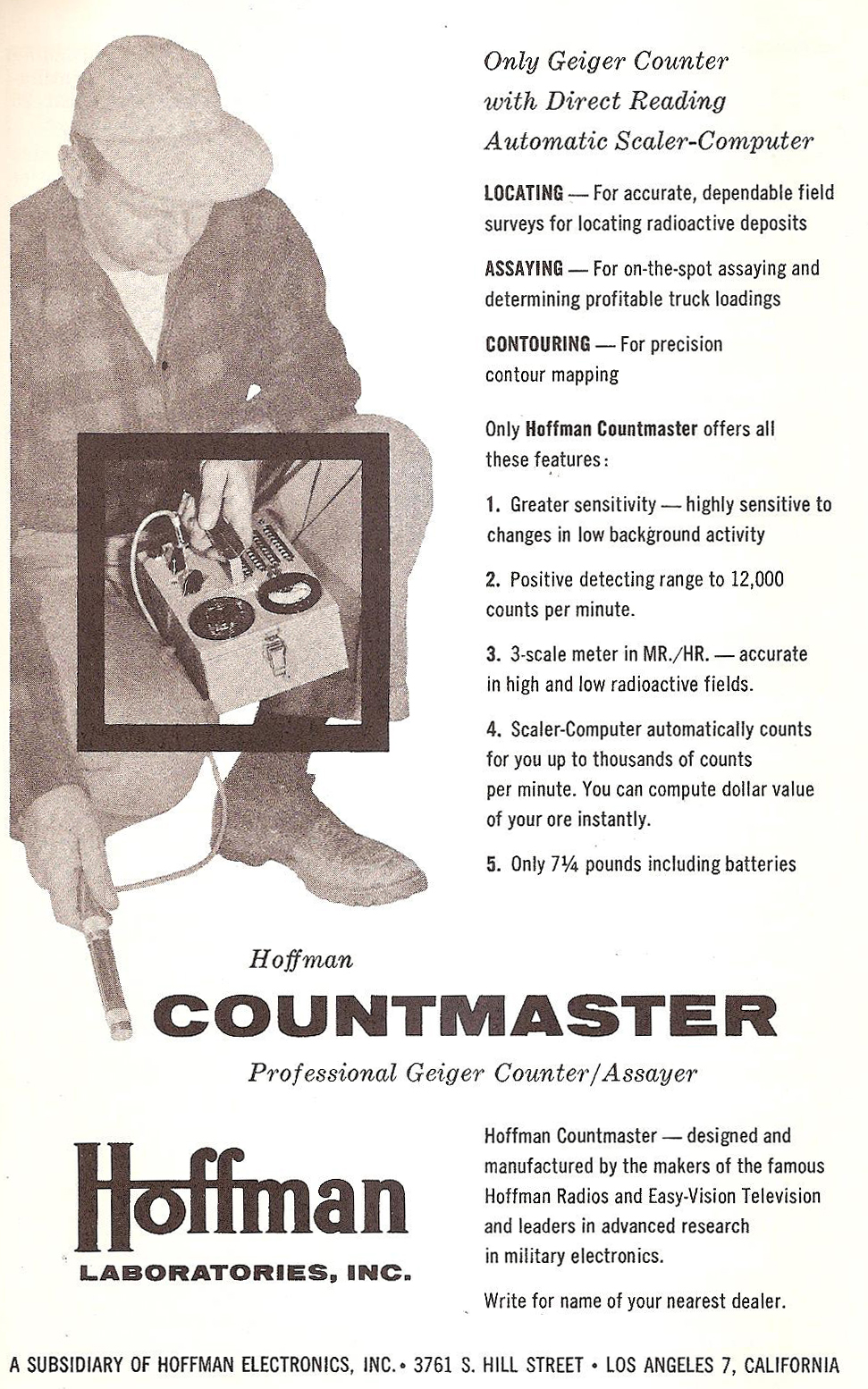
Hoffman Countmaster Ad 1955
The Forty-Niner was introduced in 1949 for use in uranium prospecting. It came with a 36" probe with the detector on the end of the probe. This design allowed the operator to probe cracks and crevices without constantly bending over.
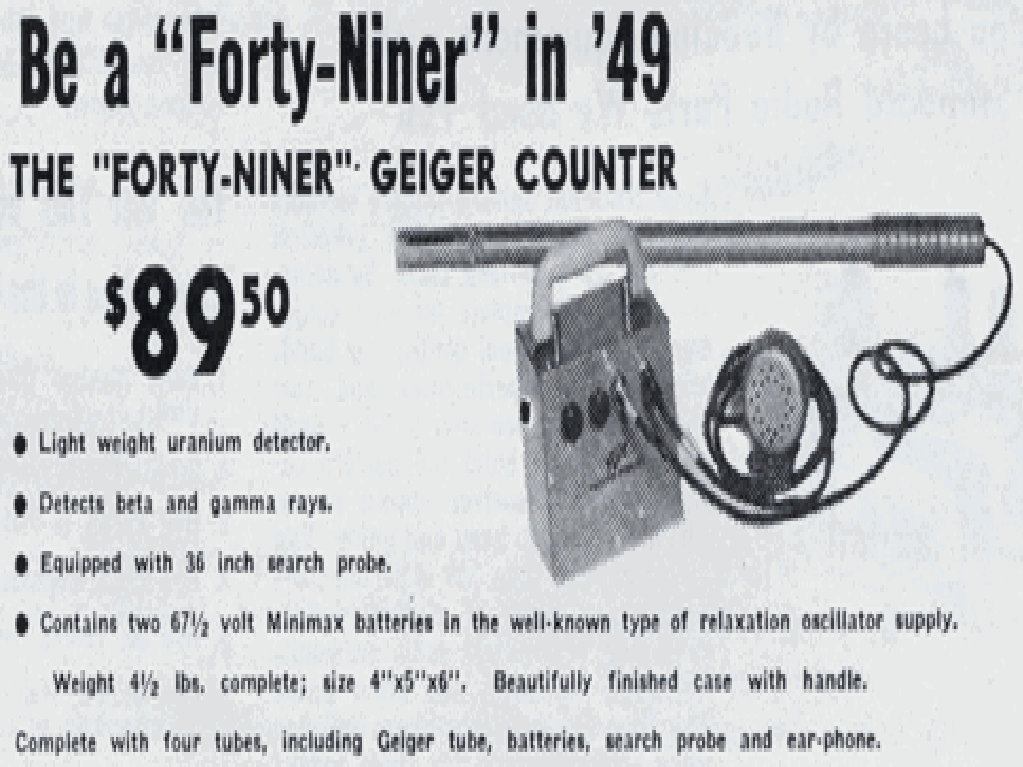
Forty-Niner Geiger Counter Ad 1949
Uranium prospecting could potentially be a rewarding hobby if you could find a uranium ore deposit. The 1955 U.S. Geiger Company ad below states the the U.S. Government will pay $35,000 for uranium found anywhere! It came with a booklet on "How to Make Money Prospecting for Uranium". The book included information of how to stake a claim and equipment needed. It also stated "Atomic Energy Commission offer due to national defense need of uranium."
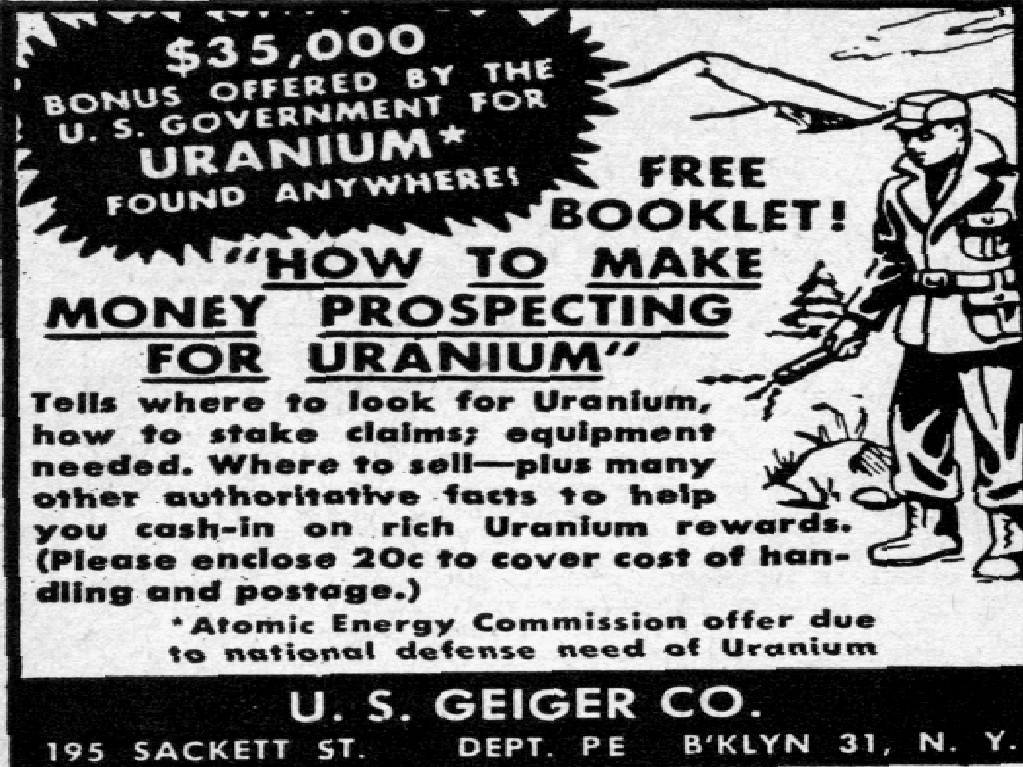
U.S. Geiger Company Ad 1955
The Mini-Scint Lode Star is a high sensitivity unit. It is easy to handle with no connecting cables and weighs only 3.25 lbs. and thus the "Lightweight Champ!" It provides easy assay reading directly in per cent uranium oxide. The unit costs $349.50.
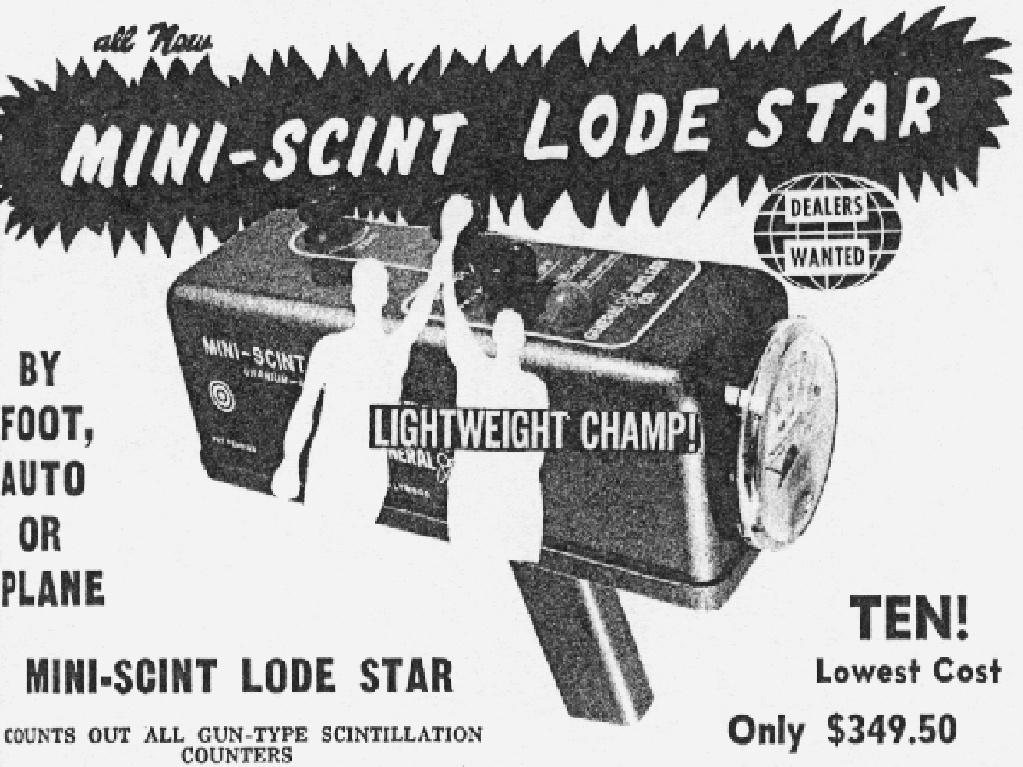
General Nuclear Mini-Scint Lode Star 1955
The Electro-Count series of scintillation counters was introduced in the mid-1950's. The Model EC-9 had an internal probe with a standard box type meter or could be used with an extension probe with a scintillator.
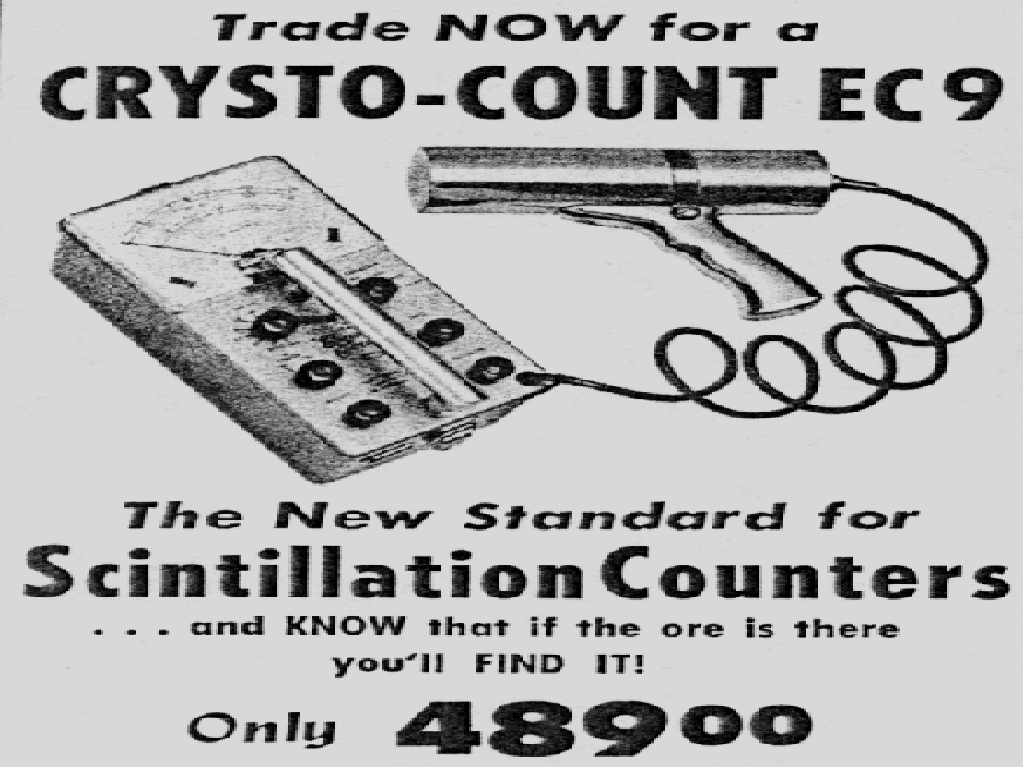
Electro-Count Crysto-Count Model EC-9 1955

Beckman Ad Model MX-8 1949
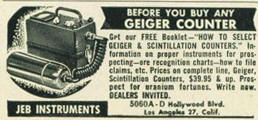
JEB Instruments Ad 1955
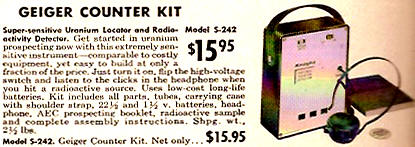
Allied Knight Kit 1956
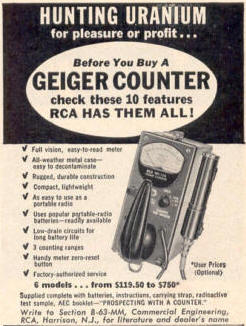
RCA Ad 1950's
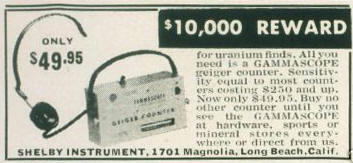
Shelby Gammascope Ad 1955

Tracelab Ad 1951

Victoreen Models 262 and 263 1947
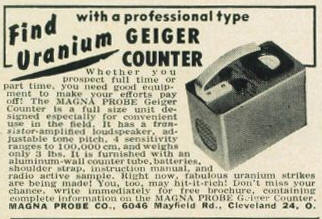
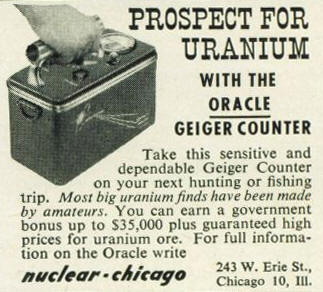
Nuclear Chicago Ad Model Oracle 1955

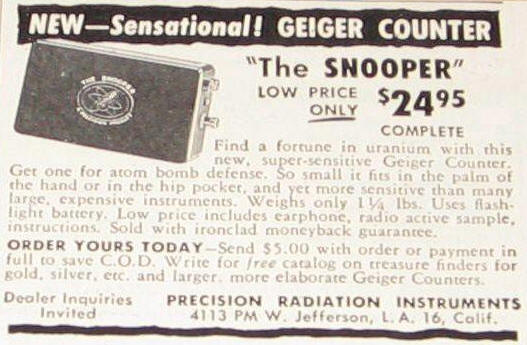
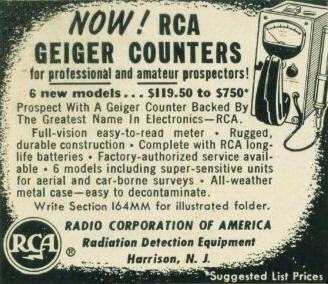
RCA Geiger Counter Ad 1955
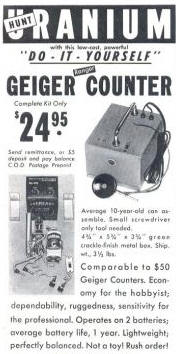
Roberts Mfg Ad 1955
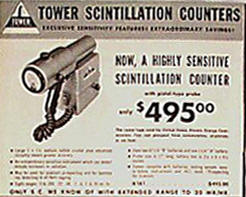
Sears Ad 1950's
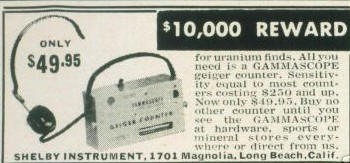
Shelby Gammascope Geiger Counter Ad 1955
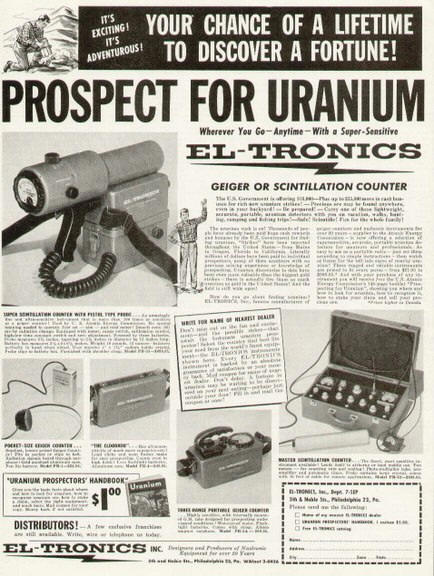
El-Tronics Ad 1955
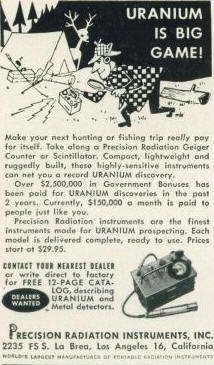
PRI Ad 1955
In May 1955, Life Magazine did an story on “History’s Greatest Metal Hunt” on the uranium prospecting craze. The article features the fashionable items required for the best prospecting. A complete kit including jeep ($1,685) could be purchased for $3,529 as shown in the picture below.

Uranium Prospecting Equipment 1955
It was also fashionable to dress appropriately for the prospecting adventure. The prospecting duds in the picture are the girl’s “Diggerette Jr.”, the mother’s “U-235” suit, and the father’s “Smock”. The article also noted that geiger counters were now being sold in the Sears, Roebuck and Montgomery Ward catalogs.

Prospecting Duds for the Family 1955
This sections provides a sampling of the variety of advertising material that emerged in the early 1950's around the growing radiation detector industry. For more examples of advertising, refer to the individual manufactures in the catalog section.
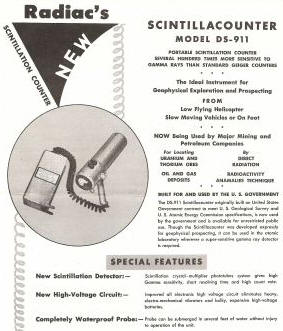
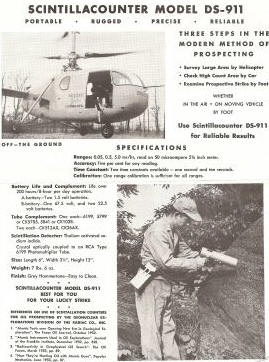
Radiac Company Ads 1950's
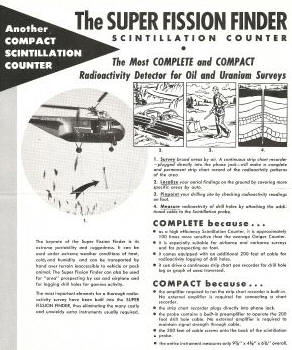
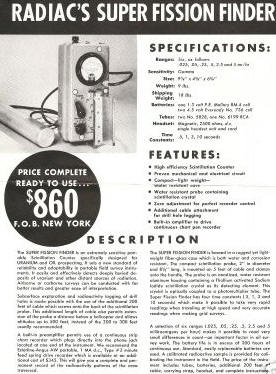
Radiac Company Ads 1950's
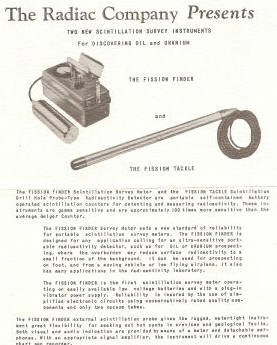
Radiac Company Ads 1950's
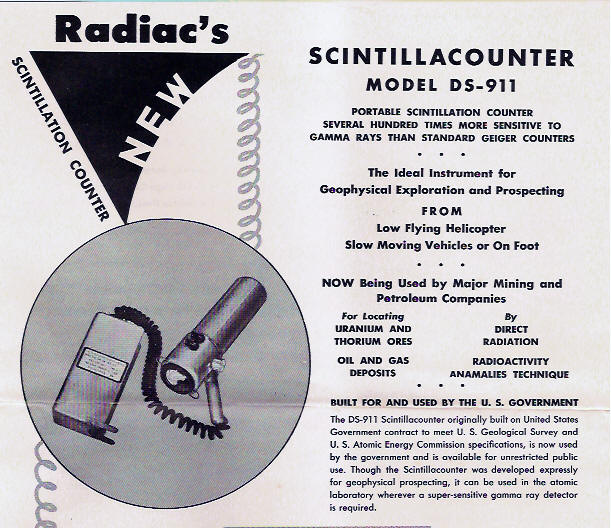
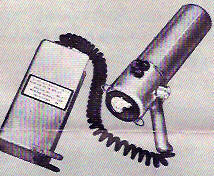
Radiac Ad 1950's

Radiac Ad 1955
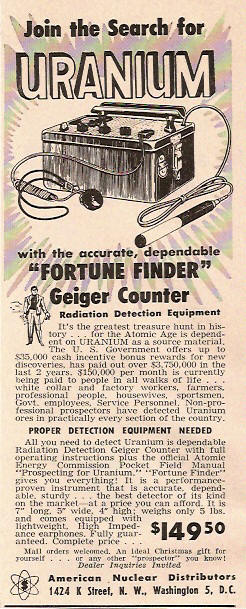
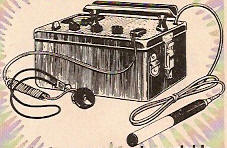
Uranium Fortune Finder Ad 1950's

White's Electronics Ad 1956
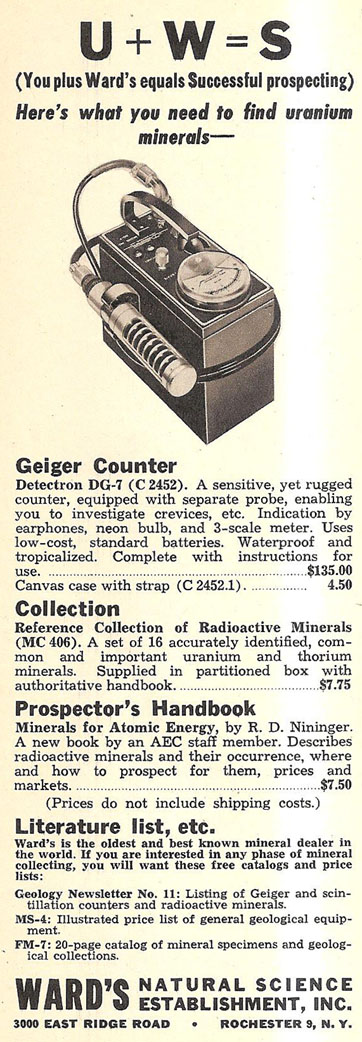
Ward's Natural Science Establishment Ad 1955